#being equally iconic in japanese since the very beginning
Text
Ranking every outfit Nora has worn
I've rated her human names and I've ranked her vessel names. Now it is time to rank all of her outfits 10 to 1. Why am I doing this? Because I'm a sucker for pretty clothes and babygirl is a fashion icon. These are just my opinions obviously so don't take them seriously. Though I am being dead serious when I say Mizuchi invented the fashion industry. What I want people to take away from this post is that we, as a society, need to respect Mizuchi's drip. No pun intended hehe
10. Childhood Kimono

No sense calling it the childhood kimono when she's always gonna be a child but idk what else to call this. I put this fit last because it's quite basic. There's not much to talk about here. I don't have any particular feelings towards it either. I do think the pink obi is cute. Mainly cuz pink is my favorite color. Also is it just me or does the kimono look way too big on her?
9. Childhood Kimono Enhanced ver.

This is the same exact fit as the last one and it only appeared in the one-shot manga bout Rabo and Yato but I want to rank it separately because of her accessory. She's just too cute with that little bow in her hair! Don't mind me fangirling over that bow like it's a national treasure. The sandals are nice new touch too.
8. Pink Kimono
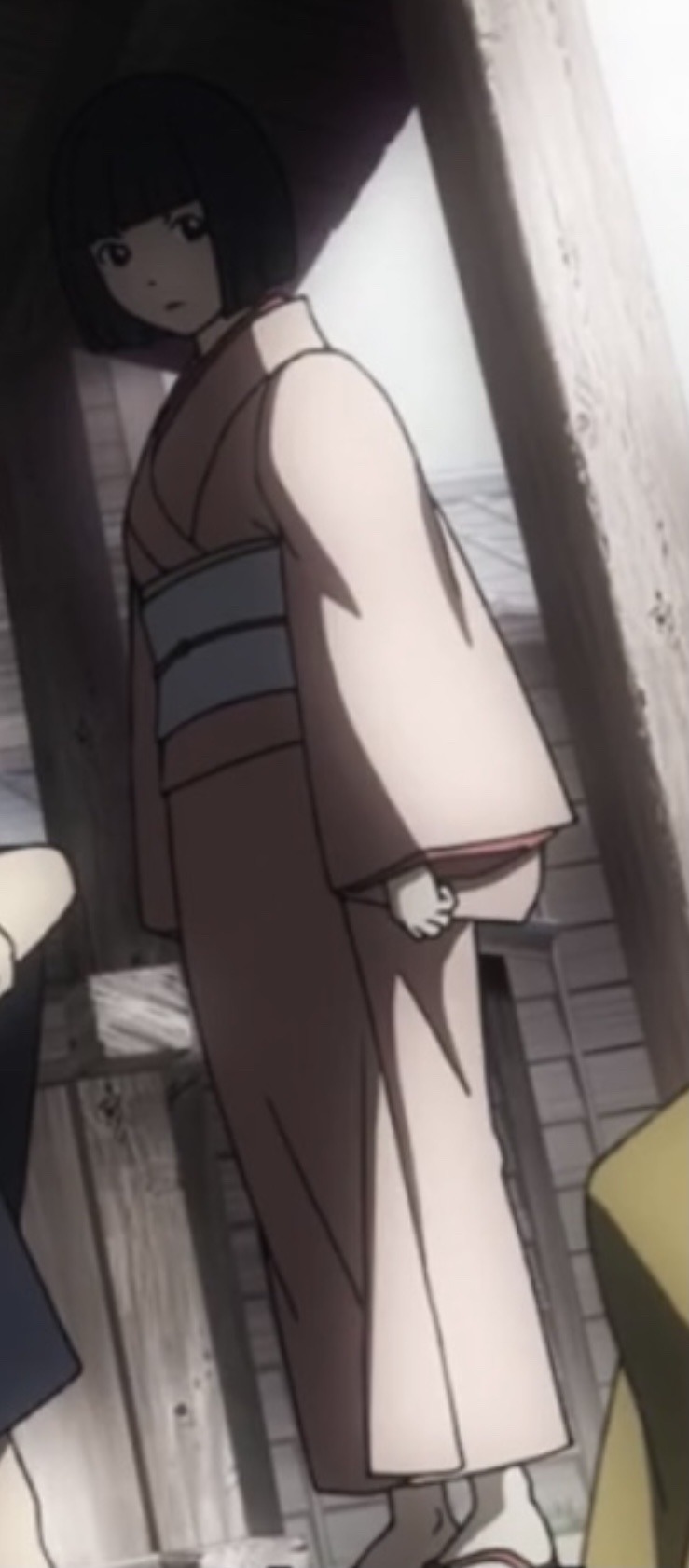
This one is only shown in anime during the flashback scene where Yato massacred the ma clan. I love this kimono because it's in my favorite shade of pink. There isn't much to say about it though. It's pretty basic so I put in this spot
7. Volume 8 Kimono
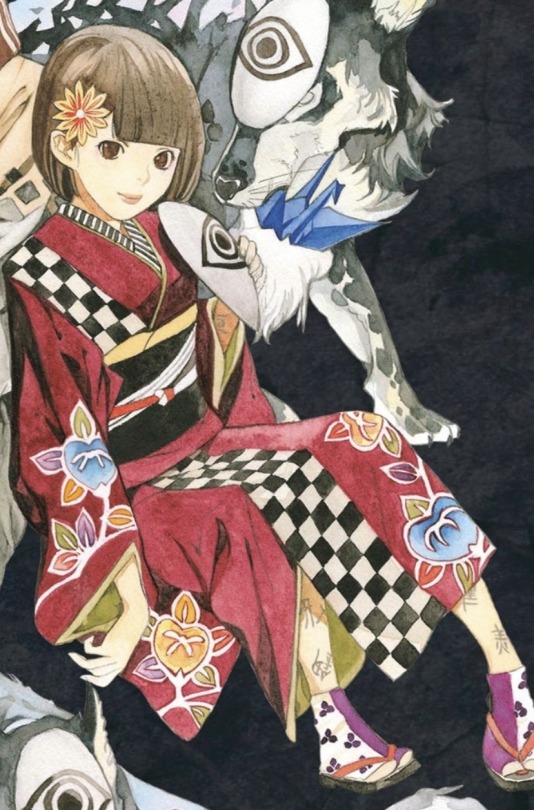
This fit appeared on the cover of volume 8 of the manga. I have to admit, this fit is kinda crazy. Like the grape (??) socks, the random checkerboard pattern, the green hiyoku, the flower pattern, the flower in her hair. It all seems very random. But I actually think it goes together well! A hot mess can sometimes turn out beautiful. I like the way she looks with a flower in her hair. Mizuchi with hair accessories equals world domination. And why tf does that ayakashi doggie have a paper crane in its mouth? That's more random than the outfit lmao.
6. Fruit bowl Kimono

This one only appeared in a colored page of the manga. Can't remember what chapter or volume it was in exactly but I think it was in beginning. This kimono is very beautiful. The pattern on it reminds me of fruit bowls lol. Babygirl rlly has the best fashion sense ever. You can't change my mind on that. And she's wearing a hair accessory here! Rejoice!
5. Boysenberry Kimono

I think the color is boysenberry but I’m not sure. My eyesight isn’t that good. So this fit is from a Kami To Enishi card. The game is discontinued but I just couldn’t not add this fit in. It’s so pretty! The color of the kimono matches her eyes which is my favorite aspect of the outfit. I think the pattern on it is supposed to be temari balls. Or maybe it's supposed to be beach balls. Of course we can’t forget to mention the bow! Tbh I don’t think it matches with the rest of the fit. But hey, it matches better than the whole volume 8 ensemble. I still like the bow and I’m glad she’s wearing it!
4. Capybara Fit

First of all, how the heck do you spell capybara? I’ve seen it spelled in 5 different ways. Second of all, I LOVE THIS FIT MORE THAN MY FUTURE CHILDREN! Seriously it’s so cute! She rocked the whole world when she put this on. I screeched when I first read the chapter this was in. That's the sheer power of this outfit.
3. Yurei Fit

Next is babygirl's classic outfit, the yurei outfit! This fit is so iconic I had to put it in the top three. I have a lot to say about it. In a way, this fit is part of the reason why I got into Noragami. Like I'm an avid horror fan and I especially love any media that has to do with yurei. Yurei are Japanese ghosts for those of you who don't know. I saw a gif of Mizuchi here on tumblr and her character design caught my eye. I thought Noragami was going to be in the horror genre because of this fit. If she wasn't wearing this fit, I probably wouldn't have become interested in Noragami at all. Thank you to the yurei fit for getting me into this amazing series. I love her personal touches to it. Like the way she wears her hitaikakushi slanted, her big obi, her gauntlets, and her hiyoku. Her hiyoku had this lil flower pattern on it in the first few chapters. That was super adorable. It's a shame she never wears it again. Yurei are usually depicted just wearing a simple white kimono and with long hair. But babygirl has her own personal touches and she has a bob cut. She is rlly out here being a trendsetter for dead people in Japan. A round of applause for this fit.
2. Flower print Kimono
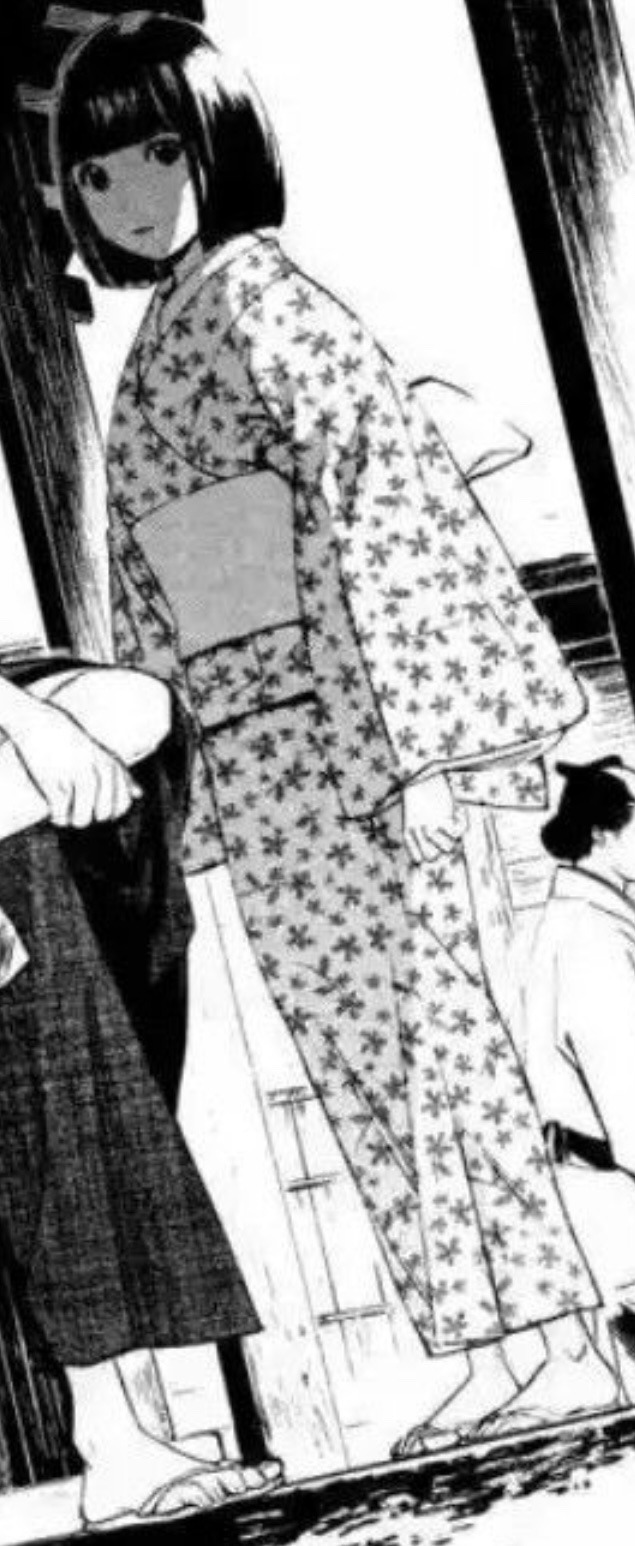
Excuse the poor quality pic. You've probably figured out by now that I have a thing for flower patterns lol. That's exactly the reason why this is my second favorite outfit of hers. It's one of her more simple fits. But I think it's to die for! Pun fully intended ;) If I remember correctly, in the past, she and baby Yato stole this from someone they killed. Sorry but I find that hilarious. R.i.p to whoever this kimono belonged to. You may have been killed but you didn't die in vain because a rlly cute girl has your kimono now. I wonder if babygirl would ever pull this out of her closet and wear it again. She may not even have it anymore since the flashbacks where she wore this were like centuries before Noragami takes place. This kimono might've already become tasty grub for moths :(
1. School uniform Fit

Of course, the school uniform is first. This fit literally invented the fashion industry! No one can tell me otherwise. Words can't fathom how cute babygirl looks in this. As a school girl who's been to multiple schools with uniforms, I think I'm qualified to say that Mizuchi looks better than anyone else in a school uniform. It's not just how she looks either but also the fact that Hiyori gave it to her. That really warms my heart. This fit did so much for the world. Like I've said before, it will go down in history as one of the best things to happen in fiction.
#nora noragami#noragami#mizuchi#hiiro#tsutsumi#furuhime#eyami#nora the fashion icon#if i missed an outfit don't tell me#i'll probably cry if i find out#it took me days to make this
28 notes
·
View notes
Text
James Bond Thoughts: 1962-1985
I'll be listing the films and my brief thoughts on them in the order I saw them, which is just a touch out of order.
004: Thunderball (1965, Connery)
I liked this one alright. In the first hour, I felt the film was way too slow, as this was the first pre-Craig Bond film I had ever seen. By the second hour, I had warmed up to the older pacing and style of the film. The underwater fight scene at the climax was impressive at the time, if not super cool to a modern viewer such as myself. Terrible title.
Should've been called: Stakes Under The Sea/Two Whole Nukes
005: You Only Live Twice (1967, Connery)
The old fashioned racism towards Asian culture made this one difficult to watch now, but the bones were fine. Clearly defined stakes, an exciting climax, fun without being too campy. But it is hard to look at the screen when Sean Connery is "disguised" as a Japanese person. Not a great title, especially since the "rebirth" of Bond is just a throwaway gag at the beginning.
Should've been called: Spaceship Eater/[CONTENT REMOVED DUE TO RACIAL INSENSITIVITY]
001: Dr. No (1962, Connery)
This was one of my favorites. It is a lot more barebones than the other Bond films, but that makes it more of a compelling spy thriller rather than having an emphasis on stunts and gadgets. Dr. No himself delivers a great performance with an amazing death scene. Easy to remember name, since it is also the villain.
Could've been called: Bikini Prime/The Man With The Metal Hand
002: From Russia With Love (1963, Connery)
Another good spy movie. The mechanics of the plot make at least a little sense, and the tension between Bond and the love interest actually matter in this one. Plus, this is the closest we get to a "Bond equal rival", especially with the excellent opening scene showing Russia's top agent actually killing a henchman in a James Bond mask in a live fire training session. The train scene at the end is iconic. Great title, actually makes some kind of sense.
Could've been called: Cryptographer's Delight/Into A Trap
003: Goldfinger (1964, Connery)
This is probably my least favorite of the initial five consecutive Sean Connery films. The villain isn't very menacing. His plan seems too over-the-top to be realistic but not far-fetched enough to be compelling. James Bond spends far too much of the movie in captivity. However, the ending somewhat redeems the film with the amazing moment of all the US marines standing up after faking their deaths at the sabotaged poison gas. Goldfinger's iconic golden gun seems silly and out of place. Oddjob fails to accomplish anything of note with his iconic razor hat. The golfing scene and poolside card cheating scene are good fun though, establishing an excellent motif in the Bond films of James outsmarting cheaters. Decent title since it is the name of the villain, but did he even have a golden finger?
Could've been called: Horse Farm/Fat Man Takes It All
006: On Her Majesty's Secret Service (1969, Lazenby)
I am torn on this one. Lazenby does an...okay job. He spends most of the film in disguise as a posh genealogist, which ironically seems more natural for Lazenby. Blofeld's constant recasting doesn't do wonders here either. In fact the whole film has a bit of a fever dream feel to it. The whole allergy thing is a bit silly, especially the chicken allergy hypnosis scene. This marks the first appearance of winter sports in a Bond film, which becomes all too familiar during the Moore era, even down to a luge chase during the climax. The ending scene is gut wrenching admittedly, even if only referenced once (that I have noticed) in future films. Terrible generic title. Also I had forgotten that this movie features a mobster boss begging Bond to marry his daughter.
Should've been called: Allergy Farm/In The Lord's Name
007: Diamonds Are Forever (1971, Connery)
Too campy. Connery too old. A couple fun moments but a lot of wasted potential, like wasting the gimmick of 2 Blofelds instantly. Some fun stunts, like Bond ascending the side of the casino, but generally a boring watch. The bit where James Bond pretends to have just killed James Bond while impersonating a diamond smuggler was fun, as was the preceding elevator fight. Fine title, if a bit on the nose.
Could've Been Called: Stays In Vegas/Smuggled Abroad
008: Live and Let Die (1973, Moore)
The first Roger Moore film. Kind of a crossover with the blaxploitation genre, with predictably awful results. Terrible twist of the two villains being the same man. Terrible villain scheme of plotting to provide...free heroin. Feels like an imitation of a Bond film. Title now iconic because of the song, but nothing to do with the plot. Terrible death scene where the villain pops like a balloon.
Should've been called: Addiction's Delight/[CONTENT REMOVED DUE TO RACIAL INSENSITIVITY]
009: The Man with the Golden Gun (1974, Moore)
Christopher Lee carries every scene he is in, Everything else here sucks, including his villainous plan...to sell solar panels...for a price. The climax where Bond defuses a laser beam is groan inducing. Moore continues to be a bit wooden in this one. I suppose the title is fine, but the gun itself is a bit silly.
Could've Been Called: Million Dollar Bullets/Assassins' Business
0010: The Spy Who Loved Me (1977, Moore)
The first good Roger Moore Bond film! This one clearly borrows from the earlier films. The "ship eats smaller US and Soviet ships" from You Only Live Twice. The Russian blonde defector from From Russia With Love. The twin nukes from Thunderball. Bond riding in a trolley and freeing prisoners from You Only Live Twice. The tense nuke defusal from Goldfinger. Moore looks the part and acts the part in this one finally, and we get a competent love interest more than ever here. This is Roger Moore at his finest as Bond. Jaws even debuts here! The title even works well here.
Could've been called: Triple X/Double Agent
0011: Moonraker (1979, Moore)
This one just kind of sucks. Even before the space stuff starts, the film is campy and boring. The only good moment I can recall is when Bond noscopes a potential assassin that was supposed to gun him down during a hunting "accident". The villain is villainous at least, but his grand scheme is completely out of the blue right at the end. Of course the film goes off the deep end once Bond goes to space. Jaws is here, somehow, but his joke-y romantic subplot manages to steal the show because of how little competition there is. The cable car scene is an example of a particularly poorly paced action scene before the space shenanigans even start. Don't even talk to me about how Jaws and his girlfriend survive an exploding space station. Also please do not talk to me about the increasingly tired trend of the film ending with everyone seeing Bond in bed with a girl. I guess the title itself is fine, but the moon is 0% involved with this film.
Could've been called: Bond vs. Jeff Bezos/The One With The Space Crap
0012: For Your Eyes Only (1981, Moore)
This is isn't particularly bad, it is just boring. I recall very little about this film other than winter sports, a girl so young that Bond turns her down, a girl avenging her parents, and Bond climbing a cliff for far too much of the film. Paced poorly. Title means nothing to the film aside from a single throwaway line.
Should've been called: Dig Two Graves/Under Attack (Like ATAC? Get it?)
0012.5: Never Say Never Again (1983, Connery)
Not a canonical Bond film, but we watched it all the same. Remakes Thunderball but changes enough to stay interesting. It goes to show that all the Bond films are so similar that a direct remake is still different enough. Somehow Connery seems more full of vigor than he did in Diamonds are Forever. The lack of James Bond theme is disturbing and all the replacement music stinks. Not a bad film, definitely better than half of the Moore films. Terrible title, again just a throwaway line, although it is more of a meta-commentary.
Could've been called: Thunderballs/From The Brink
0013: Octo...you know (1983, Moore)
First off, worst title for a Bond film ever. Otherwise, a surprisingly...fine Bond film. I could do with less clown footage in my Bond and the climax is a bit nonsensical, but this one generally delivers the goods. Too much circus screentime and the villainous scheme of "sell fake faberge eggs" isn't enthralling.
Should've been called: Literally Anything Else/Easy Side Up
0014: A View to a Kill (1985, Moore)
Absolutely bonkers, but a bit of fun in its own way. Too campy, too zany, but Christopher Walken gives a great performance. Moore is far too old by this film and it really undercuts the many romantic scenes. Iconic title because of the song, but nothing to do with the plot. Way too much skiing and horse screentime.
Could've been called: At Fault/Back In The Saddle
So, there it is. I wanted to record this before all this information left my mind. So far, I vastly prefer Connery over Moore. Of the Moore films, The Spy Who Loved Me was the only one I felt like really resonated with me, while I was pretty fond of the first five consecutive Connery films on the main. I suspect that the Dalton and Brosnan films will vary, but sit somewhere between the extremes of From Russia With Love and Moonraker.
1 note
·
View note
Text
BLOGTOBER 10/4/2020: SOCIETY
Without having a survey to back me up, I feel comfortable asserting that as a horror fan, you go through different phases with SOCIETY. It’s a basic fact of life, and yet it morphs and mutates underneath you, shocking you anew just when you think you’ve got a grip on it. You never forget your first time, because there is simply nothing like it. Then, after you get over the initial shock of its patented brand of body horror, you start to take it for granted; it's so broad and monolithic that it becomes something like the Grand Canyon--when it’s not right there in front of you, you begin to experience it more iconically, as part of the wallpaper of existence, rather than an in-your-face confrontation with the limits of experience. Then, you revisit it every few years (or months, depending on what sort of person you are), and the prophylactic layer that your brain has wrapped around your memories of it--the one that allows you to think of SOCIETY as a fun, wacky cheap thrill--begins to crumble, and you realize all over again how iconoclastically vile it is. Wherever you happen to be at, with this inimitable genre landmark, you'd be hard pressed to deny that it earns its royal status among horror movies, just for being so uniquely fucked up.
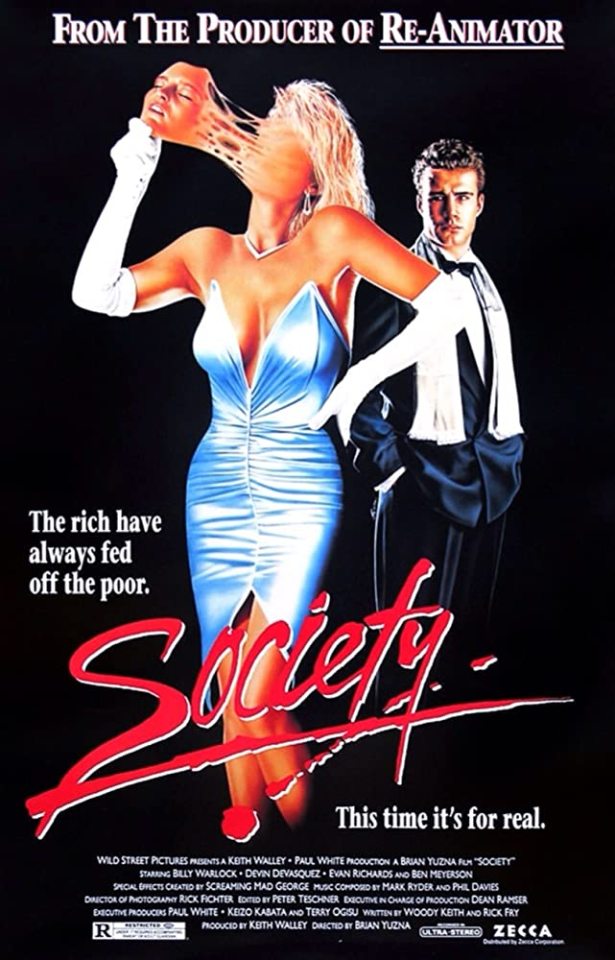
Filmmaker Brian Yuzna is best known as the co-creator of the indispensable RE-ANIMATOR (or as the co-writer of HONEY, I SHRUNK THE KIDS...depending on what sort of person you are, again), itself a milestone achievement in the blending of sex and gore that so characterized '80s horror production. That film clearly brought out the best in Yuzna and frequent collaborator Stuart Gordon (also of HONEY, I SHRUNK THE KIDS fame...among other things), but it's interesting to see how they operate apart, to understand the unique ingredients that each filmmaker brought to the more perfect union of their classic Lovecraft adaptation. Gordon skewed darker and more intellectual, as evidenced by the end of his career with the shattering mob thriller KING OF THE ANTS, the disturbing true crime drama STUCK, and the Mamet-penned EDMOND. Yuzna, for his part, is almost anti-intellectual, preferring to cook up blackly comic, semi-pornographic nightmares like his two increasingly horny RE-ANIMATOR sequels, the terminal S&M fantasy RETURN OF THE LIVING DEAD 3, and the shamelessly hokey comic book adaptation FAUST: LOVE OF THE DAMNED. Yuzna's lack of shame is really his defining feature as an artist, and nowhere is this more obvious than in his directorial debut and signature masterpiece, SOCIETY.
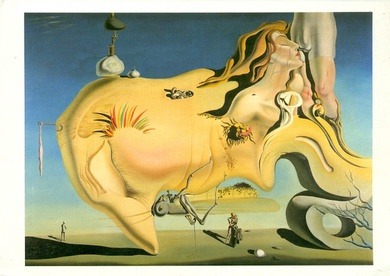
Salvador Dali's "The Great Masturbator," a chief visual inspiration for SOCIETY.
Yuzna was able to leverage the success of RE-ANIMATOR to lock in two directorial opportunities, BRIDE OF RE-ANIMATOR, and a bizarre body horror exercise about a Beverly Hills orphan who discovers that not only are his adoptive family from a different bloodline, but they're not even from the same species. That both pictures employed the writing team of Woody Keith and Rick Fry gives you a little taste of what to expect from SOCIETY, but to be frank, the latter threatens to make the former look like a very special episode of ER; "overkill" barely begins to describe SOCIETY’s ambitious assault on the human body. In a recent interview, the philipino-american director giggles perversely, "I think my friends were a little embarrassed for me (when they saw SOCIETY)," and this sound bite reminded me that the last, most important ingredient that Yuzna contributes to any project is unabashed joy. It's a little hard to imagine stomaching SOCIETY without it.
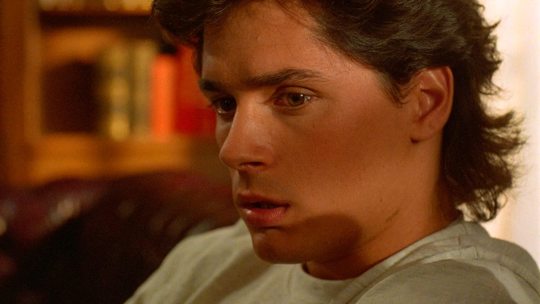
In this unusual scene from the class struggle in Beverly Hills, Billy Warlock (son of HALLOWEEN 2's Michael Myers, Dick Warlock) plays Bill Whitney, a rich, handsome, athletic high school student with a heavy duty anxiety disorder. Although he appears to have it all, he is plagued by nightmares and hallucinations, reflecting suspicions that the family that spoils him is also out to get him. Perhaps this is all understandable, though. Bill is under a lot of pressure these days, with his parents devoting all of their attention to his sister's coming out party, and his narcissistic girlfriend pushing him to ingratiate himself to the assholes higher up the social ladder; it's enough to make any teenager feel alienated and insecure. But, do these garden variety anxieties account for his visions of his sister's body deforming itself unnaturally, or the dubious evidence he finds that her debutante ball involves incestuous orgies and human sacrifice? Is Bill simply crumbling under the strain of societal expectations, or is the friction with his shrink, his parents, and his peers all symptomatic of an elaborate plot against him by elites who are truly less than human?
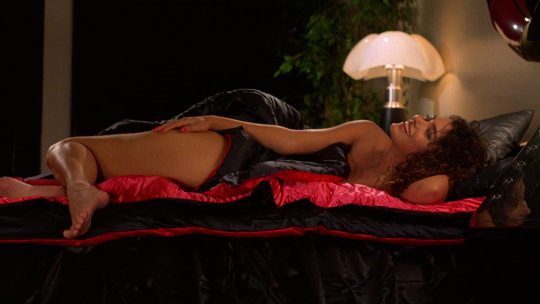
I can’t believe they use this cheapo blanket trick MORE THAN ONCE in a movie that is famous for its unforgettable special effects, and I guess I kind of love it.
In case I haven't made the answer abundantly obvious, I'll add that while SOCIETY is the purest expression of Yuzna-ness on the market, it has an important co-author in Screaming Mad George. The eccentric japanese FX master, whose name is apparently an amalgamation of Mad Magazine, Screamin' Jay Hawkins, and...George, has produced some of horror's most outrageous makeup and visual effects, mostly for Yuzna, many of them in SOCIETY. If you've seen even a trailer for Alex Winter's 1993 oddity FREAKED--which is itself a grossout criticism of American social standards--then you are already familiar with SMG's trademark style. He specializes in twisted perversions of the human form that would make a cenobite blush, driven by a penchant for puns, and influenced equally by THE THING's Rob Botin, and Big Daddy Roth’s Rat Fink style. Screaming Mad George is instrumental in articulating Yuzna's premise: that behind the shimmering veneer of success and sophistication, the upper class are just a bunch of degenerates, who literally degenerate into something unimaginable behind closed doors. It's impossible to imagine SOCIETY without his sinuous, slithering monstrosities, or his indescribable realization of their most important social event, "the shunt".
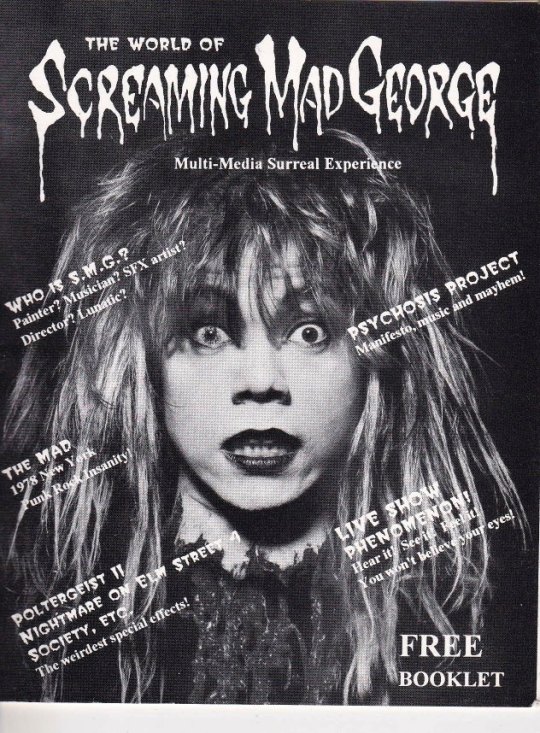
One of many great images from a zine I wish I owned, on SMG’s Facebook page.
It's easy to get overwhelmed by SOCIETY's visual impact, but its message is just as potent now as it was at the end of the Reagan era: Rich people are not only different from the rest of us, but in fact, they aren't even human. Writers Keith and Fry make an interesting choice of hero to help put this across. A lazier writer would have selected any archetype from the Freaks and Geeks set to create an easy Us vs Them tension, but SOCIETY is led by a promising young man who, for reasons he himself does not yet understand, is just not "the right kind of people". Bill appears to have every advantage in life, including a level of popularity that wins him presidency of the debate team despite his nerdier rival’s superior prowess--and yet, he suffers from a stigmatizing psychiatric disorder that is the natural result of feeling indefinably different from one's peers, and intuiting that, as a consequence, they don't even really like you. The shallow jock with deep-seated emotional problems is a much more interesting protagonist for this kind of social allegory than the charismatic outcasts that you get in movies like THE FACULTY and DISTURBING BEHAVIOR, for whom the idea that the elites could be aliens is just de rigueur.
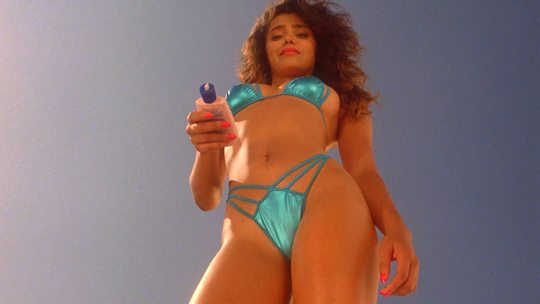
It's worth noting that this complexity of character extends to Bill's love interest, sympathetic society girl Clarissa Carlyn (Playboy Playmate Devin DeVasquez). At first, she seems villainously eager to introduce Bill to the many splendors of "the shunting", but as the plot against him mounts to its horrifying conclusion, she defects. There appears to be a reason for this, although honestly, this is the most difficult part of SOCIETY for me to wrap my head around. Clarissa lives as an essentially independent adult, only burdened by her mother (Pamela Matheson), a possibly brain damaged hulk who lurks in and out of various scenes just to be disturbing, always announced by some toots on a tuba, before eventually siding with our heroes. I'm really not sure what's supposed to be going on in this part of the movie, except that this character contributes to a number of distasteful jokes. But, I hold on to the idea that by virtue of whatever disorder Mrs. Carlyn suffers from, she serves the purpose of priming Clarissa to rebel, since her very existence makes her daughter something of a societal outcast herself. That's the best I can do.

In any case, everyone working on SOCIETY commits completely, with Mrs. Carlyn being no exception. The movie's climactic orgy of the damned is an all hands on deck operation, just as reliant on Screaming Mad George's artistic abilities as it is on the actors' responsibility to make you believe that this fucked up shit is really happening. There's a visceral patina of sleaze spread over the entire film, dripping from the way that characters talk to and touch each other, flirting and flaunting their bodies in a distinctly unseemly fashion, even when it stays within the realm of mundane reality. This constant sinister, insinuating attitude on the part of the whole cast lays the foundation for what is to come, and while I appreciate everybody's hard work, my favorite performance is from an actor who only comes in at the very end: David Wiley as society king Judge Carter. Wiley's career consisted almost exclusively of the most ordinary sort of television work, which makes his outrageous turn in this alien porno flick all the more respectable. While other characters transition from suspicious pod people to full-on mutated perverts, Judge Carter has to show up just for the finale, establish his authority, rip off his clothes, and plunge straight into a sea of slime, happily fisting his way through the cast. Wiley meets this challenge with aplomb, making of himself a hybrid of Robert Englund and Gene Hackman, perfectly embodying the movie's joyful absurdity, and never betraying the slightest hint of embarrassment.

SOCIETY is very much a don't-look-down type of endeavor, a fairy that could expire at the slightest lapse in faith. There's a visual pun in the last act that's so gross, so offensive, so frankly idiotic, that I don't have the courage to describe it; my whole body tenses up when I know this scene is coming, as if it were the meat hook scene in TEXAS CHAIN SAW MASSACRE or the brutal rape in the middle of SHOWGIRLS. I don't like it, but at the same time, I respect Yuzna's unhesitating commitment to show it to me, and I think that actor Charles Lucia should get some kind of award for shouldering the burden so valiantly. SOCIETY is a daring movie in the truest sense, a film with more balls than brains, and in this it exposes the limitation of intelligence and taste, and the real need for pure transgression, in producing art of any real value. You might argue with me about whether Yuzna's masturbatory magnum opus really qualifies as art, but to respond to that, I'll quote the great transgressor Alejandro Jodorowsky: "If you are great, EL TOPO is a great picture. If you are limited, EL TOPO is limited." So stick that in your shunt and smoke it.
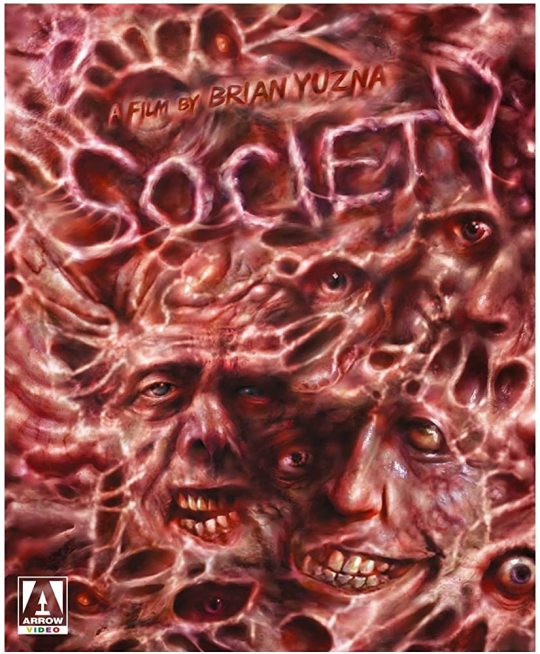
undefined
youtube
PS Here, have this stuck in your head for the rest of your life.
#blogtober#2020#society#brian yuzna#screaming mad george#woody keith#rick fry#billy warlock#Keith Walley#devin devasquez#david wiley#horror#black comedy#satire#body horror#social criticism
27 notes
·
View notes
Text
The Road To “Godzilla VS. Kong”, Day One
KING KONG VS. GODZILLA (AMERICAN VERSION)

Originally Released: June 26th, 1963
Director: Ishiro Honda
Writers: Shinichi Sekizawa, Paul Mason and Bruce Howard
Starring: Tadao Takashima, Kenji Sahara, Ichiro Arashima, Mie Hama, Michael Keith, Harry Halcomb
youtube
“King Kong VS. Godzilla” is a movie whose reputation often precedes it amongst certain circles of Genre Film fans. Even if one is unaware of the convoluted, more than slightly seedy story behind its creation (short version: the original “King Kong”’s special-effects artist, Willis O’Brien, was interested in creating a sequel that would have pitted Kong against a giant animalistic version of the Frakenstein Monster, but shady producer John Beck wound up stealing the idea and, when American studios balked at the project for fear that the use of stop-motion animation to realize the effects work would be too expensive, wound up shopping it to the more cost-effective Toho Studios in Japan, who reconceived it as a new “Godzilla” project in hopes of revitalizing interest in the character), it is still one of the most singularly important Giant Monster Movies ever made. For one thing, it basically defined The Kaiju Movie as we know it today; sure, the original “Gojira” from 1954 (and by extension its Americanized adaptation, “Godzilla: King of the Monsters” in 1956) may have effectively created the genre, but you’ll notice the majority of such movies that exist today are more about Fanciful Title Bouts between two Clashing Monsters rather than somber moody Allegories about the horrors of Nuclear Weapons. For another, it’s the movie that really put Godzilla himself on the map as a Big Star in his own right; at the time, he only had two prior films to his name, and while one of them was the aforementioned genre-creating watershed “Gojira”, the other was “Godzilla’s Counterattack” from 1956, which proved such a box-office disappointment that it put the character into retirement for the better part of a decade (and to give you a sense of just how much less weight the name “Godzilla” carried back then, when that movie was released in America in 1959, it was initially re-titled “Gigantis The Fire Monster”). With “King Kong VS. Godzilla”, however, he would begin to star in more and more movies, building a film franchise that continues to this day.
So it’s a bit of a shame that I’ve never liked it all that much.

To be clear, the “it” in question here is specifically the American version of the movie, which is the one most Western audiences would be familiar with since, until recently, it was the only one readily available to us (though Criterion finally corrected that back in 2019, when they included the original Japanese version of the movie as a bonus feature in their “Showa Era” collector’s set). Certainly, it’s the one that I grew up watching as a kid, when my mom, ever so protective and knowing how easily upset I could be when Fictional Characters I Loved got hurt, made sure to watch ahead to see who exactly won the title match-up (and since it was Kong, I wouldn’t actually get around to finishing my viewing of the movie for a good long while). Back then, of course, I viewed it very much through that childish prism of who I thought should win, and it was exactly the kind of Schoolyard Logic you’d expect: Kong was supposed to be a great deal smaller than Godzilla, and where Godzilla had his iconic fire breath, Kong had no extraordinary powers; Kid Me understandably concluded that this match-up really ought to be a shoe-in for Godzilla, which worked out well since Godzilla just so happened to be the one Kid Me actually cared about. Kid Me was thus quite irritated to discover that, for the sake of this movie, Kong had in fact been significantly sized up and given random electricity-absorbing powers. It felt like cheating to Kid Me, and it left me less than positively disposed towards the film proper.
These days, of course, I’m able to give the film a somewhat fairer shake, though I would be lying if I said that My Inner Childish Fan-Boy is completely quiet on the matter (in particular, it always bothers me that, to emphasize the advantage Kong’s electrical powers give him in their fight, the movie explicitly cites Godzilla’s “vulnerability” to electricity, despite one of the most singularly iconic images of the original “Gojira” being his ability to walk straight through a power-line barricade). Indeed, my most recent re-watch for this very review honestly left me feeling fonder toward it than I was even on my last most recent re-watch (back in 2014, in preparation for the then-upcoming Gareth Edwards “Godzillla”, which we’ll also be getting to in this re-watch soon). The portrayal of the title monsters themselves in particular left me much happier this time around than it has in the past; the design for Godzilla himself- thick around the center with big heavy-browed eyes and what appears to be a constantly self-amused grin, huge sharp claws that dominate the fingers and a tail that moves with a real sense of weight and purpose-took me a long time to warm up to, for example, but these days I would happily cite it as one of the very best of the original series. Kong gets it a bit worse, sadly; the suit they design for him here (a fact that original “Kong” director Merian C. Cooper openly despised, incidentally; the idea of portraying Kong as just some guy in a gorilla costume was one of the things he explicitly set out to avoid in the original movie) has a distinctive enough face if not an especially memorable one, but the costume always looks and feels a bit raggedy, with the sagging pecs and ill-fitted arms (throughout the movie the suit switches between “regular” arms designed to allow the actor mobility, and extended arms to help give it a more ape-like gait; the result is that both versions feel weirdly out of place on the costume a lot of the time) looking especially awkward. However, even beyond how they look, the way the monsters act is genuinely enjoyable, with Haruo Nakajima as Godzilla and Shoichi Hirose as Kong both putting in fantastic performances that imbue them with a great sense of personality that is just consistently delightful all movie long. Whether it’s Godzilla hopping around, arms flailing in triumph whenever he manages to pull off another victory, or Kong drunkenly swallowing up giant pots’ worth of a narcotic usd to keep him docile, the movie very visibly delights in imbuing these creatures with fun foibles, and It’s no coincidence that the it’s at its strongest, not so much when the monsters are fighting, but when they are simply interacting as actual Characters: Godzilla here feels often like a particularly arrogant, boundlessly-energized child, while Kong is a bit more confused and subdued but quick to anger when irritated; their first meeting, when both these strong visible personalities most openly bounce off each other, is unquestionably my favorite moment of the movie.
The rest of it isn’t exactly bad, per se, but it is a lot less entertaining. Some of that is simply what the American version inherited from the Japanese original, not least of all the noxiously racist portrayal of the Natives living on a remote pacific island with Kong (here named “Faro Island” for some reason instead of the usual “Skull Island”). On top of the sins it recreates from the original “King Kong” (a fairly ooga-booga understanding of What Islanders Are Like, all of whom are portrayed by non-Native actors slathered in brownface make-up), it also includes a decently insulting bit wherein the initially-hostile islanders are pacified by the introduction of “magic” in the form of a hand-held radio and cartons of cigarettes. There’s also the fact that the plot is driven almost entirely by Random Contrivance rather than anything that flows naturally from either the characters or the premise; Godzilla and Kong have no real compelling reason to meet, let alone fight, other than the pure coincidence of their both happening to be active at around the same time in the same part of the world (the American version attempts to ameliorate this somewhat by stating that the two are “instinctive rivals” who will be “naturally driven to destroy one another”, but that flimsy lip-service to Motivation just winds up making the otherwise-arbitrary plotting feel all the worse), and we are constantly bombarded by Total Coincidences as a way of shuffling the characters around from place to place with dizzying frequency. But some of those troubles are only exacerbated by the approach the American version has taken to the material. We’ll talk about this more tomorrow, but the Japanese “King Kong VS. Godzilla” is, at heart, a Satirical Comedy; this, unsurprisingly, was not an idea that went over well with Universal Studios in America, who chose to try and reshape that comedy into a more traditional Monster Movie. An understandable objective, but not one the Japanese cut of the film made easy to achieve; to avoid the most overt Comic bits meant cutting almost all of the human characters in the film (most notably the eccentric executive Mr. Tako, played by Ichiro Arishima) down to only their most essential appearances, which in turn means that they all wind up feeling vaguely undefined and out of place in their own story (this feels especially true of our ostensible main character, Tadao Takashima‘s Sakurai, who is present enough to FEEL like a main character but has little left to do in this cut of the film). To make up the weight of all that cut footage, meanwhile, we get gobs of new footage consisting mostly of Michael Keith as a United Nations reporter talking at us in the most stultifying way possible, often joined by Harry Holcombe as an equally stultifying scientist (who apparently gets his knowledge of dinosaurs primarily from children’s picture books, which in fairness would explain a lot of the nonsense he ends up saying), though he also frequently talks with a fellow reporter played by James Yagi. These scenes are not, perhaps, without their charms, but they also deaden the movie’s pacing, especially since nine times out of ten they exist mostly to reiterate stuff we already know because it literally just happened. Given how much a faster pace seems to be one of the American cut’s top priorities (a sub-plot from the Japanese version about a submarine inadvertently encountering Godzilla is reduced to a single sequence for this version), that choice proves a counterintuitive one.
Because the other major problem with the American approach to this movie is that, to be frank, the Monster Action is nowhere near Epic enough to bear the weight this new cut puts on it. Again, it’s not without its merits; Godzilla and Kong’s outsized personalities do a lot to lend even the less effective sequences a certain fun spirit, and there is still an unmistakably strong sense of craftsmanship to the miniatures used throughout the movie to create the appropriate sense of scale for our Monsters to play around in (the demolition of a recreation of Atami Castle shines a spotlight on that very fact). But in terms of both their scope and their choreography, there’s just not enough There there; far too often, “King Kong VS. Godzilla”’s Big Marquee Action Scenes amount to the monsters just sort of lazily throwing rocks at each other, or else engaging in less-interesting recreations of their previous Iconic Moments (Kong especially goes through a truncated version of his original appearance’s third act, though here he ends up on top of the National Diet Building rather than the Empire State Building). That’s slightly less of a problem in the Japanese version; again, there, the main thrust of the film lies in its comedy, and thus the Monster Action being relatively lightweight is less of a hinderance and more a spicy Flavoring to the main story. But here, it is the main story, and while it’s pretty clear some real love went into the Effects Work (the puppetry especially is very solid; there are a few instances where the switch from Suit Actor to Puppet for Godzilla is borderline seamless, and I also enjoy the decently-animated feel of Kong’s facial puppet as well) it ultimately doesn’t have nearly enough substance to fill that role. This comes through especially clearly in the Final Showdown between the monsters; again, there is some deservedly iconic stuff here (Kong trying to shove a tree down Godzilla’s throat only to have it rebuffed in a puff of flames has become an impressively-enduring Meme for a reason) but, much like most of the story, winds up being driven far more by Contrivance than anything clever or satisfying (a bit where Kong knocks himself over feels especially annoying for how unmotivated it seems to be). It was always going to be a tall order to make a match-up with as much implicit weight to it (both metaphorical and literal) live up to the heightened expectations placed on it, maybe. But even taking that into account, it’s hard not to feel like “King Kong VS. Godzilla” could have put a little more effort into things.
Still, I was saying, at the start, that I walked away from “King Kong VS. Godzilla” happier this time than in many of my past viewings. And that is ultimately true: for as much as I find myself often wishing it could be a different movie, the movie it actually is already does manage to work decently well on its own terms. The dub-work here in particular honestly deserves notice; in contrast to the standardized casts Toho would start using for most of its “Godzilla” movies moving forward, here we get a more distinctive sounding voice-cast who manage to put some real Life into their performances (the voice they give to Kenji Sahara’s Fujita stands out especially to me, nasally and over-earnest but capable of some real Fire when the moment calls for it, as befits the character). And, again, whatever my beef with the Action Scenes, the actual portrayal of the Monsters really is uniquely fun (indeed, given how many other elements Toho would consistently crib from it, I’m often surprised that Godzilla’s distinctive body language throughout isn’t one of them), which winds up giving the movie enough Real Heart in the end to make it a positive Experience overall, even against the stuff that even now stands out to me as Not Up To Snuff. At the very least, it’s a lot easier for me to recognize how and why this movie created the Legacy it did, even if the American Version makes a bit more of a mess out of it.
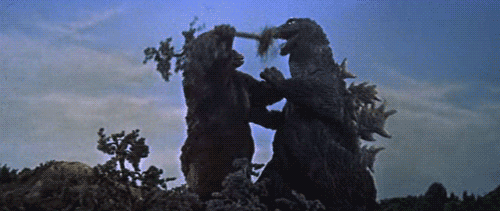
#godzilla#king kong#godzilla vs. kong#kaiju#theroadtogvk#movies#review#ericthemason#my writing#king kong vs. godzilla
6 notes
·
View notes
Text
31 Horror Movies for the Halloween Season
Well.. It’s a little bit over 31 bc of sequels and such but it’s a fun title for horror recs! For the record these are in no particular order in like what’s the best or anything! It’s just a list of horror movie recommendations that might get you in the Halloween mood. I tried not to have huge well-known movies on here, but I did throw in a few just because I love them and couldn’t resist. I did try to add small descriptions for each one, but given there’s like 31 movies on here, they are rather short. Either way, hopefully you’ll find one or a couple movies here that you’re interested in!
1. Trick ‘r Treat
A rather well-known one but is it really a list without Trick ‘r Treat? A fun horror anthology with four different stories that connect to each other in some way - including the fact they all take place on Halloween night! A fun one to actually watch on Halloween.
2. Hell House LLC
For the record there are two sequels (Hell House LLC 2: The Abaddon Hotel & Hell House LLC 3: Lake of Fire), however I have not seen either of them so can’t include them here, but if you want to watch them I’d say go check them out! Basically it’s a documentary style type film that follows what happened up to the days a horrible tragedy took place on the opening night of a haunted house attraction. No one knows exactly what actually went down, so the reason for the documentary is to attempt to figure out what truly happened that night.
3. Repo! The Genetic Opera
A horror musical! It’s set in a future where organ failure is extremely common so naturally a huge company comes along and is like “Okay you can have an organ transplant, but you have a huge payment plan and if you can’t pay then we’re just gonna kill you and take your organs back.” Also it has so many good songs would highly recommend if you haven’t seen it (and you can stomach a bit of gore).
4. The Devil’s Carnival & Alleluia! The Devil’s Carnival
Another horror musical! And done by the same people who did Repo! For the record The Devil’s Carnival is only about an hour long but the sequel is a full length movie! A short quick explanation is that it’s set in Hell (unsurprisingly) and follows the people who end up there - also during this the Devil is planning an attack - but I’ll let you find out the rest if you haven’t seen it yet.
5. Ju-On and/or The Grudge (Any Film)
It’s my favorite horror franchise, so of course Ju-On was gonna end up on here! Whether it be the original Japanese films or the American remakes, it follows vengeful spirits who were murdered in their home and are taking revenge on anyone who enters.
6. Sinister & Sinister 2
Okay I know Sinister 2 is one not very well liked, but since I have seen it I decided I might as well include it (though I don’t really remember my thoughts on it it’s been a while). Video tapes that contain children murdering their families and a mysterious being that may be at the center of it is the basic plot for these movies.
7. Tragedy Girls
Basically you got two best friends who capture a serial killer because they themselves want to become serial killers! Don’t wanna say too much outside of that, as that is the basic plot concept honestly, but it’s a really fun movie.
8. The Final Girls
A girl dealing with the anniversary of her mother’s death ends up, with a small group of others, stuck in a horror movie that her mother actually starred in. Okay as much fun as this one is it does pull on the heart strings a bit I gotta admit. But it’s truly great and naturally has a feel of an older slasher movie.
9. You Might be the Killer
Another one that’s got that older slasher movie vibe as it takes place at a camp. One where the counselors are getting picked off one by one by a masked killer. Comes in our protagonist, who is calling his friend, who isn’t at the camp and also is a huge horror enthusiast, for help to figure out what to do and maybe figure out what’s going on/who the killer is.
10. Danur (aka Danur: I Can See Ghosts)
A young girl who just wants friends finds them in the form of three potentially paranormal ones. Though it seemingly being just a childhood thing, it actually becomes of great importance as she gets older. This movie also has a sequel, Danur 2: Maddah.
11. Fright Night
For the record I am talking about the remake here, as I have not seen the original, but if you would prefer to watch that one - or maybe even both - go for it! Basically, teen starts to believe his new neighbor is a vampire after more and more people go missing. Also David Tennant is there if you go with the remake so that’s always fun!
12. Tales of Halloween
Admittedly I wasn’t too into this film, but I know a lot of people like it! Not too much to say, it’s a horror anthology with 10 different segments that take place on Halloween! So you’re bound to find something you enjoy within it, whether it be the paranormal, witches, or even just dumb fun horror comedy antics.
13. The Tag-Along
Based on an urban legend from Taiwan, “The Little Girl in Red”, it focuses on a man and his girlfriend. Of which the man’s grandmother suddenly goes missing one day - eventually leading to him discovering clues of a potential unknown little girl who had began following his grandmother around. There are two sequels to this movie as well that I have not seen yet, that being The Tag-Along 2 & The Tag-Along: The Devil Fish.
14. Three... Extremes
Another anthology film that contains three separate stories, each one coming from a different East Asian country. It also has a prequel, Three (or 3... Extremes II in the U.S.), and a full length film made from one of the stories within it, Dumplings.
15. The Hallow
Really feel like the point of this movie is like ‘Don’t fuck with the woods’. As it basically focuses on a couple and their baby, who seems to be the target for the odd things happening to them that seems rather connected to the woods nearby.
16. The Devil’s Candy
A man moves with his family into a new home, and slowly begins to feel as though something is possessing him in a sense. That and also the potential fact his family is being targeted by the previous resident of the home.
17. Wake Wood
Apparently FMA did not teach us not to fuck with the dead enough, so here’s a movie about a grieving couple that lost their daughter who move into a town that holds the power to bring someone back from the dead for only 3 days. Unfortunately like FMA, things go horribly wrong (just not... in the same way as FMA).
18. The Cabin in the Woods
College students go out to a cabin in the woods in which things quickly take a turn for the worst. Seems simple enough, but it’s so much more complicated than that - however I won’t be sharing any of those details for those who haven’t watched it yet.
19. Prevenge
A pregnant woman who’s husband has recently passed away, believes that her unborn child wants her to track down and kill everyone who was involved in the accident. An extremely wild but honestly rather fun time.
20. You’re Next
Home invasion, baby! In which everything goes to hell for a family and their partners when masked killers start trying to kill everyone there. Though things take a turn quick and you start to wonder who is really the ones being hunted down here. (A fairly well known one, but I had to recommend it given one of my favorite characters in horror is in this movie)
21. Kuronezumi (aka Black Rat)
Not too much to say here basic plot wise. Six students receive texts from their dead classmate, they follow as the texts ask and go to the school at night, and then start getting targeted by a killer wearing a rat mask.
22. Lights Out
A family potentially being haunted by a creature that only appears when the lights go out? Plus a whole lot of family drama? Always fun truly! It’s also somewhat based off a viral short film of the same name that the director had made before he got to make it a full length film.
23. Absentia
Absolutely had to put a Mike Flanagan movie on here. One that focuses on a pregnant woman who’s started towards attempting to move on with her life after her husband disappeared seven years ago. However, as she takes a huge step towards doing so, something rather odd happens - which I’ll let you find out for yourself if you choose to watch it.
24. Halloween III: Season of the Witch
Perhaps it’s because it’s the one Halloween movie without Michael Myers, or perhaps it’s because I was blanking out on movies I watched that aren’t extremely well-known, but I felt the need to add this one on here. It focuses on this man who is out to kill children on Halloween by using a line of Halloween masks. So basically another fun one to watch on Halloween!
25. The Barn
Teenagers go to a barn where there’s a supposed curse that can awaken Halloween-themed monsters on Halloween night. What could possibly go wrong? Honestly another one that would be a lot of fun to actually watch on Halloween.
26. Behind the Mask: The Rise of Leslie Vernon
A really fun documentary type film where it’s set in a world where iconic horror slashers are actually real! And a documentary crew are out to make a movie centered around Leslie Vernon, who wishes to go down in history as another one of the famous slashers. This one is really just *chef’s kiss* to me, very much recommend if you haven’t seen it.
27. Creep & Creep 2
Found footage type films in which we follow people who are hired by this rather concerning man to film him. That’s really all I can say unfortunately without trying to give away too much.
28. What We Do in the Shadows
Another documentary-style type movie! It tends to be more comedic than it is horror, but it follows a group of vampires that live together! Sort of documenting their lives and how they survive day by day. Honestly it’s so ridiculous and hilarious, and I know many people have seen it by now but I have to recommend it none the less as it’s one of my favorites. Plus, it also has an equally hilarious tv series now that you can also give a watch!
29. The Banana Splits Movie
Who doesn’t want to see the Banana Splits as animatronics that start randomly slaughtering people after the news that their show is going to be cancelled? Honestly it’s really just a fun, ridiculous movie that isn’t meant to be taken seriously. Perhaps something to watch with friends to get in the mood for Halloween.
30. The Last Exorcism
Another one that has a sequel I have not seen: The Last Exorcism Part II. Another documentary style film (Sorry I added so many of these whoops), that follows a reverend who goes around performing fake exorcisms. Things start getting a bit more complicated though when lines start beginning to blur between what is real and what is fake while doing his current “exorcism” he was asked to perform.
31. V/H/S & V/H/S 2
There is also a third film, V/H/S: Viral, however I have not seen that one. Not too much to say here, they’re basically just an anthology of short horror films that are supposedly being shown from VHS tapes.
#horror#horror movies#horror movie recs#horror movie recommendations#repo! the genetic opera#the devils carnival#Ju-On#the grudge#halloween#trick r treat#youre next#the cabin in the woods#theres way too movies here to tag them all im gonna stop here#sorry for the wait#leslie vernon#okay now im done#wait#What We Do in the Shadows#okay N O W i am done#horror recommendations#horror recs
548 notes
·
View notes
Text
That Demon, Skin Crawling
I received a request from @working-dreamer to share my thoughts on Yunbastian’s cinematic record solo. Specifically the moment where he quivered before the solo starts.
In order to understand the scene, I shall unpack the tiny details that built up towards that moment. It is going to be a LONG post, because every second is filled with the HYPER details that Furukawa Yuta is famous for.
Since Forever
Right after Ciel was officially decorated Earl of Phantomhive, it seemed like Sebastian was testing his contractee’s resolve. “Status, wealth, and a beautiful fiancée, all belongs to you now. Now, how about giving up on this foolish revenge and live a life of happiness like this?” The poisonous temptations of a demon. The boy replies: “That does not sound bad, But...!”
Yunbastian was highly skeptical, but decided to give the contractee a second for whatever BS he’d have to say before devouring him. Little did Sebas know that his benefit of the doubt would be rewarded with something he had been starved of: the feeling anticipation.
“The reason I came back here is not to pursue happiness. I came back to fight!” The boy said with strength and determination in equal measure. Yunbastian was shocked to the point of being frozen mid-pounce, a hand over his chest, as though in a vain attempt to calm his heart.

He almost allowed the grimace to take over his facial expression, but willed it under control just in time. The demon faced his master again in human guise, as though nothing was up.

From ‘Demon & Butler’ to ‘Demon Butler’
For the first time in their contract, Yunbastian knelt down before his master, and when he extended his hand, the butler grabbed for it with extreme eagerness, his entire body shifting along with his movement.

“Knelt down for the first time”? No, obviously it was not the first time Yunbastian was on his knees, as before this ⇈ scene he already knelt twice at least ⇊. However, in both instances he simply knelt down FOR the boy to adjust his height to him; he never knelt down BEFORE him out of reverence. Here Furukawa paid extraordinary attention to conveying the difference between ‘kneeling’ and ‘kneeling before someone’, minding the tiniest details such as:
distance between his legs
the speed with which he would descend
and the presence/absence of his iconic tail-flip before kneeling down.
(More details about thise in this post)

As Furukawa puts it, this ⇊ scene in the cinematic record is likewise the first heartfelt “Yes, my Lord” Sebastian ever said. Before speaking the phrase, Furukawa bit his lips and took a deep breath. The meaningful pause reminding us of the immense weight these three words carry, and the hand over his chest clenching, communicating the sincerity behind his phrase.

It was in this moment that Sebastian was no longer ‘the demon’ and ‘the butler’ - ‘truth’ and ‘guise’, but instead became ‘the demon butler’.
That Butler, Exhilarated
His master pulled his hand away, but Yunbastian maintained his pose. The way he kept the hand to his lips was as though he was savouring the imagined aftertaste of the imagined flavour of the boy’s soul.
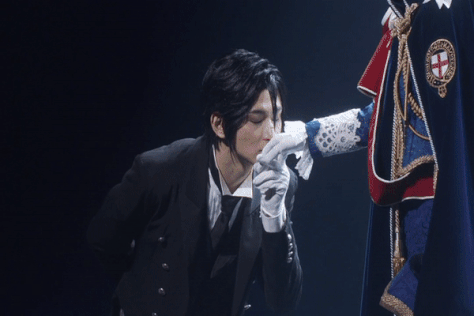
The flavour was imagined, and therefore the limits to the deliciousness were also boundless. As @working-dreamer also said, it looked like Sebas was either laughing and crying. I personally think that Yunbastian also didn’t know which one to do, so settled with both. Can we imagine how excited Sebas must have been to finally have something to look forward to? Anyone who has experience with inability to feel anticipation must surely understand the ecstasy of feeling something for the first time.
Furukawa portrayed a demon that had lived on pestering their contractee, or searching for glee in finding loopholes to preserve their autonomy. A survival mechanism almost, just to keep themselves going until they can fill that empty stomach.
Once turned into ‘Sebastian Michaelis’ however, for the first time in forever did he look forward to exist in his contract and the process towards getting his payment. It was like he was finally fully alive again.

This excitement is something Yunbastian holds very dear. In the total darkness of the stage we see Sebas getting up and going in the direction of where his master left. It was like a chef who is drooling over the meal in the making; the unfinished product already so delicious he wants to eat it before it can be served.
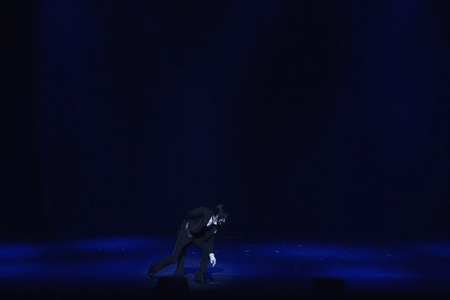
But Yunbastian decides against it, shook his head and turned back again. “No. Patience,” he must have thought.
That Demon, Skin Crawling
Yunbastian calmed himself and his most famous solo begins. We know the demon’s many wicked expressions, and we know what he wants. But then Yunbastian showed us this ⇊ most angelic, pure and innocent smile on a demon’s face.
Personally I find this the most skin crawling thing about Yunbastian, because he MAKES YOU feel happy for him like we’re supposed to be happy when a starved child finally gets food. He MAKES YOU feel happy that he is going to manipulate a child into death, into a supposed ‘afterlife’ that is worse than going to Hell. And it works a bit too well, and we are left with the question: “what is wrong with us!?”

Then immediately after showing us Angelbastian, he seamlessly transforms into the monster again, confirming that he is a multi-faceted creature with many feelings like us humans do. “He is not a beast going after a child’s life, he just wants food because he’s starved!”
In just a second, Furukawa managed to ‘humanise’ this Trash Demon™ for us, make us feel sympathy for a mass murderer.

Yunbastian looks at the hand that previously held his master’s, as though imagining he can eat it already while saying the words: “delicious beyond all.”
I translated the phrase into ‘delicious beyond all’, but in Japanese it is: “滴るほどに” (Shitataru hodo ni), literally meaning: “to the point of dripping”. When sung by Yunbastian, it might as well have been a metaphor for drooling. This too reflects just how true and raw Sebastian’s feelings are.
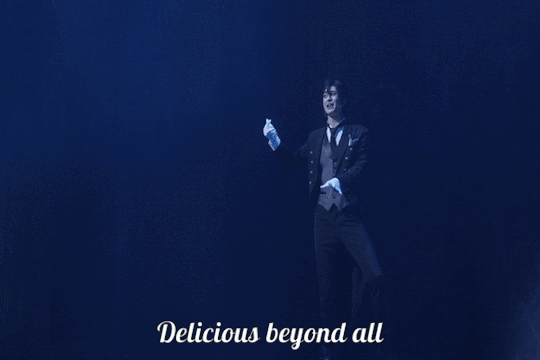
It is the last phrase of the solo, and as though the impact was not enough already, he repeats the line shouting, falling on his knees in a way that ‘the butler’ would never.
This is the ultimate reminder that ‘Sebastian Michaelis’ is still the hungry demon behind the mask of a perfect butler. The ultimate proof that the core objective for the demon to remain on Earth is to eat a child’s soul.
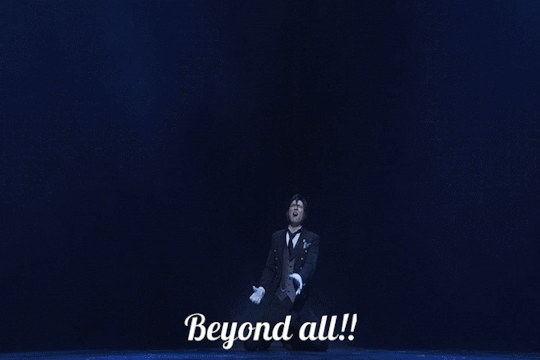
This is but a very short scene, but within three mere minutes, Furukawa’s HYPER detailed acting managed to:
express the ENTIRE essence of this complex character,
summarise the demon’s past, present AND future,
‘humanise’ a demon whose morals cannot possibly be justified within human standards,
all without minimising any of the trashiness of Trash Demon™
Now, THAT’S acting if you ask me. When Yana said that Furukawa understands Sebas better than she does, it really might not be as grandiose an overpraise as people think... TOHO, your favourite cow is legit.
#Furukawa Yuta#Yun#Yunbastian#Yunbastian I love you#Sebastian Michaelis#HYPER detailed acting#Kuromyu#Kuroshitsuji#Black Butler#Musical#Tango on the Campania#Cinematic Record#Analysis
166 notes
·
View notes
Text
My Top Ten Anime, a chaotic list
This was so hecking difficult, I’m gonna have to do some ‘honourable mentions’ for ones I can’t bring myself to leave out. This list is based entirely on my personal feelings, not an objective assessment of what are logically the best anime. There also may be mild spoilers at points because I can’t control myself. Doing this in quarantine cause I looove ranting about things I like.
10) Attack On Titan
This was the first anime I ever watched, and it blew my mind a bit tbh. The music is iconic, and the animation is great as well. It might have been a bit harrowing for my first experience with anime, but I absolutely loved the story. It’s set in a world where titans (man eating giants) have driven the dregs of humanity to live within giant stone walls. There’s a group of humans trying to research titans, kill them, and protect humanity, and the main character decides to join them after a titan breaks through one of the walls and his mother is eaten. It’s one of those where you think you know everything and suddenly the world gets turned upside down by a new discovery. All the puzzle pieces start fitting together the longer you watch, and you find out that everything going on is much bigger than what it originally seemed (government conspiracy time lads). The plot twists are unpredictable (for me at least) and devastating, and the emotion this series evokes is awesome - you can FEEL the sheer desperation of the characters, their rage and despair as they fight again and again against a seemingly unending enemy. Despite almost every battle being a suicide mission and despite too many losses, the characters keep going out of the human need to survive and protect.
10/10 for brutality and gore, but also theme of hope.
9) Naruto
A founding father of anime. Surprisingly not one of the first I watched, in fact it took me a few years to start. It’s set in a feudal Japan where ninjas are the defenders and servers of the people, and different villages have different ninja styles. Naruto is a young boy with a dangerous spirit sealed inside him which has caused him to be shunned by society (even though it’s not his fault??), and he wants to become a ninja. First off I’m a sucker for the Naruto archetype: dumbass, cocky, obnoxious, but kind and loyal too. Years of solitude and ostracisation as a child mean that Naruto desperately wants people to acknowledge him, and he intends to become the Hokage to prove himself. There’s a huge range of characters and villains, all with cool ninjutsus and different philosophies. Friendship, power, and determination are some of the main themes and it makes me so proud to see my son *COUGH* Naruto progressing and learning from his mistakes. It IS a long boi though and I haven’t even finished Shippuden yet, but I think Naruto captures the essence of shounen anime and is a great underdog story. Manga is lit too.
10/10 for cool battles and great characters.
8) Psycho Pass
One of the earlier anime I watched, and it became an instant favourite for the way it makes you question morality. It’s set in a kinda dystopian future Japan, where a technology called the Sibyl System checks people’s mental state and determines their ‘crime coefficient’ - how likely they are to commit a crime. The main character is a young woman who joins the police and begins to realise that blindly following this system is perhaps not the best way to go about things. For example, they have special guns that automatically kill people whose crime coefficients are over a certain level, but she soon proves that you can easily lower someone’s coefficient by talking them down and negotiating instead of killing them off immediately. It’s got great drama, great government conspiracy, compelling villains, and some really badass characters. It pushes the question of what is right or wrong, and how far technology should go when it comes to justice.
10/10 for sociological debate and horror elements.
7) One Punch Man
OPM is an anime that stands out for me, partially for mocking the tropes of battle anime, and partially for the uniqueness of the main character’s predicament. It’s set in Japan where heroes and villains exist, and the protagonist is a man called Saitama who gained superstrength after doing 100 push-ups, 100 sit-ups, 100 squats, and a 10K run every day. However he’s become so strong that he can defeat every enemy with a single punch. Nothing is a challenge for him anymore so he becomes depressed and unfulfilled; he’s still a good man who helps people, but he feels he’s missing something from his life. A cyborg called Genos makes Saitama his master, determined to learn his ways and they become friends. It’s one of the first anime that made me laugh out loud; it’s funny and entertaining, but also shows us that power is not equal to happiness.
10/10 for moral lessons and good jokes.
6) Tanaka-kun is Always Listless
The only slice of life anime on this list and not very well known, however it has a special place in my heart. The main character Tanaka is a boy who dozes off constantly and acts exhausted when awake; he loves expending as little energy as possible. His best friend Ohta looks out for him and essentially makes sure he doesn’t get lost/ be late/die on a daily basis, including carrying him when he just falls asleep sometimes. Although Tanaka seems uncaring, it’s shown that friendship isn’t a bother to him, and he realises that he actually relies on his friends despite saying he likes being left in peace. His friends all have great personalities, my personal faves are a tough gangster girl who’s rude to everyone EXCEPT her adorable loli girlfriend, and a popular girl who’s trying too hard to fit in and starts to become more herself after befriending Tanaka. All the characters share one brain cell, and it’s genuinely a funny anime - I’ve burst out laughing watching it a few times. Also Tanaka and Ohta are extremely shippable if you want to go down that route; it’s said several times in the series that they’re like an old married couple.
10/10 for wholesomeness and comedy.
5) Ouran High School Host Club
Another lighthearted show, probably the anime that’s made me laugh the most out of any. It’s set at an academy for rich-as-heck kids, and there’s a ‘Host Club’ where all the girls go to drink tea with a group of handsome boys. There’s the cunning Kyouka, prankster identical twins Hikaru and Kaoru, stoic Mori, adorable Honey, and princely but obnoxious Tamaki. Haruhi, a working-class scholarship student who is mistaken for a boy, accidentally breaks a precious vase and is forced by the host club to join them to pay off her debt. The group of boys realise fairly quickly that haruhi is a girl, but she becomes a popular host amongst the girls (LOVE the secret lesbian vibes) so they keep up the charade. I think I have a weakness for groups that share one brain cell because aside from Kyouka, they’re all idiots. I also love how flexible the show is with ideas of gender and sexuality despite being a slightly older anime. The daily antics of the host club combined with their personalities is a recipe for comedy, and they’re all lovable in their own ways.
10/10 for characters, drama, and comedy; it’s well-paced too.
4) Bungou Stray Dogs
Set in an alternate modern Japan where some people have secret abilities that can be activated, this anime became an obsession when I first watched it. The cast of characters is amazing and the villains are awesome too. Atsushi is an orphan who discovers he can turn into a powerful tiger, and is hired by the Armed Detective Agency, a small organisation of powerful individuals who fight crime. NEED I SAY ANY MORE?? Many of the main characters share names with famous Japanese authors such as Osamu Dazai and Ryūnosuke Akutagawa which is really cool and something that might add to the story more if I had an understanding of Japanese literature. Anyways the main character Atsushi is kind of a wimp at first (understandably because the world of ability-users is actually terrifying), but he learns to stand up for himself and use his ability to save people. The show’s mixing of dark and comedic tones is perfect to me; one moment a character is off his head on mushrooms and the next Atsushi’s leg is brutally sliced off in a back alley fight (it regenerates later no worries). The plot is really cool and full of intrigue, and eventually you get the whole ‘Usually we’re sworn enemies but we’re forced to become allies in the face of a greater evil’ thing and it’s great! Turns out our main guy and our main bad guy are actually a pretty powerful and efficient team, hoho??
10/10 for supernatural detectives being super cool.
3) Yuri!!! on Ice
Y’all already know what’s going on. Ice skating, emotional breakthroughs, gay shit, HIT ME WITH IT. The story follows Yuri Katsuki, an insecure figure skater trying to regain his confidence, and his self-appointed coach Viktor Nikiforov. Viktor is enthusiastic in helping Yuri train, and Yuri has been a big fan of Viktor since his childhood *throws pillow across the room*. Yuri becomes determined to, quote, “surpass Viktor’s wildest imagination”, and they end up agreeing - through a series of convoluted events - to get married if Yuri wins gold at the olympics (I think it’s the olympics??). Either fuckin way this series has angst, humour, cuteness, and god DAMN did I get invested. When Yuri was doing his free skate my own heart was beating harder than it did when I finished a 10K. Love the vibes and also it’s the closest to full healthy gay representation that I’ve seen in anime for a while. Not much more I can say, but do I really need to say more???
10/10 for GAY and MY HEART
2) Kimetsu No Yaiba (Demon Slayer)
Ok this one’s kind of a cheat cause I’ve read the manga as well which is way ahead of the anime, but FUCC. It takes place in the Taisho Era in Japan (begins 1912), where Demons exist who eat people. Tanjiro Kamado’s family is killed by a demon one night and his sister Nezuko is turned into a demon - but it is soon discovered she’s different to other demons, and can restrain herself. Tanjiro joins the Demon Slayer Corps to try and track down a cure for his sister, while proving that demons are not inherently evil. I LOVE Tanjiro as a main character because he values kindness over everything else, not forgiving demons for their sins but recognising they are tormented creatures, trying to give them peace before they die. All demons were once human - a fact that only Tanjiro seems to remember when fighting them. He’s patient, gentle, and determined - hotheaded and brash sometimes, but he has this vibe that just makes people become his friend/respect him even if they don’t intend to. He befriends two other slayers - Inosuke, an absolutely feral Best Boy who was raised by wild boars, and Zenitsu, a cowardly but ultimately loyal guy. This trio works really well together and Tanjiro is a great protagonist. Don’t even get me STARTED on the music and animation. Impeccable. Kamado Tanjiro No Uta makes me cry every time I hear it, and the water/fire effects used to show the metaphorical way the swords move like the elements takes my breath away.
10/10 for morals, music and animation.
1) Mob Psycho 100
Where the fuck do I start here. This anime is so unique in its style, story, and characters that I think it will always be my favourite. It follows Shigeo Kageyama (nicknamed Mob cause that’s what they call extras and background characters in Japan), a plain boy with incredible psychic powers that explode when his emotions are too high. Over time he’s learned to suppress his emotions, causing him to become socially inept and emotionally withdrawn. His (fake) psychic ‘master’, Reigen, uses him to make money exorcising spirits, making Mob believe that it’s for ‘training’. Mob appears naive at times, but he is so simply kind to people that it makes my heart hurt. Unlike many of the egomaniac psychics that Mob comes across, he recognises that without powers, he is just an ordinary boy. Mob’s greatest power isn’t his OP psychic abilities, but his power to show people they can change, that he can change. He forgives (and eventually befriends) people who have tried to kill him. Redemption and empathy are big themes here and they’re done really well.
The other characters are so well rounded and are also given time to grow, including Reigen - at first he’s a seemingly manipulative sleazebag, but later you see that he is a genuinely good man who has taught Mob many lessons and helped him grow up. This is a core message - Mob’s ability to change is due to support from his friends, not purely his own desire - people need other people!
This is also one of the true rarities in anime where the second season is absolutely just as good (if not better!) than the first one. The music is unique to the show, the ops for both seasons get me litty, the animation is incredible, the jokes are great and although it’s not all about big-ass fights, when we do get a big-ass fight it’s so fucking cool. The fight sequences are beautifully animated and visually stunning. MP100 makes me laugh, cry like an actual baby, and want to become a better person. Idk I could literally write pages on it like the big nerd I am but that’s all I’ll do for now.
10/10 for literally everything.
HONOURABLE MENTIONS
Given : about a boy who joins a band which helps him work through his trauma. Lovely healthy gay representation and themes of healing.
Samurai Champloo : ragtag trio consisting of two samurai - one lowkey feral and does breakdancing, the other lofty and withdrawn - and a bold young girl. Themes of friendship and journeys. I simp for the lofty samurai.
Cowboy Bebop: jazzy music, bounty hunters in space, 90s anime WHAT MORE COULD U WANT. Yet another group of characters that share a single brain cell. Love it.
9 notes
·
View notes
Text
Sarah Rogers pt 2: or, how baby!Steve imbibed a fuck-you attitude with his mother’s milk
Okay, so after looking at Sarah’s backstory, how she met Joseph and had Steve and decided to go to America, I couldn’t stop thinking about: what next? The MCU wiki is VERY thin on the ground with detail, and she’s so interesting! Plus, this is, like, one of the most criminally underdeveloped sources for Steve Rogers’ character, as I mentioned in pt 1. So, what can we reasonably source from the time to fill in the gaps?
So: I said in my previous post Sarah likely arrives in January/February of 1918. This is because in those days, travel times were long, conditions were VERY poor and you did not want to be heavily pregnant on a cheap ship to America with the conditions on board. Plus, in those days there was no guarantee a ship company would even sell you a ticket if you were visibly pregnant. It did happen, but was risky for the company, so you could never be sure. Sarah would have left asap once she made a decision.
The journey itself would have taken about 3-4 weeks. First she would have had to travel to London, because nothing would have been leaving to America from the French or Belgian coastline, as a) most of it was too close to the war and b) the bits that weren’t wouldn’t have been profitable. Travel to London from Passchendaele would have taken a few days to a week, given the mud and absolute priority troops and military materials were given on all journeys. This map here shows it took between 7-10 days to arrive in New York from London (by ship, no flights until the late 1920s/1930s) in 1914 before the outbreak of the war. I mentioned how at this point the German U-boats were basically sinking anything they found not flying a German flag, which made this journey pretty hazardous, even with the newly introduced (and very effective) protection of the convoy system. If Sarah was travelling on a fast convoy (less likely as they were primarily for troop ships) it would have taken about a week. Slower moving convoys carrying mostly cargo might have taken 2 weeks, even 2 and a half weeks if the weather was bad. Convoys, by the way, were where groups of ships were clustered together and escorted across the Atlantic by a combination of naval ships bristling with every explosive known to man, and navy ships disguised to look like harmless merchant cargo ships but ALSO bristling with every explosive known to man, to prevent U-boats sinking them. And also attack U-boats when they turned up. Not if. When.
As you may be imagining, these journeys often contained lots of Things Going Boom and people Dying in Unpleasant Ways. Sarah would have been told by literally everyone she knew that this was a stupid, near-lethal decision, and that she should just NOT. But Sarah being Sarah, ignored this in the pursuit of what she felt was right and best for her and her baby... that doesn’t sound familiar at all, does it?
Okay, so she’s made it through the journey to the iconic Ellis Island. The next problem was that Immigration to the USA was incredibly curtailed by 1918, compared to the levels of immigration to the US prior to WWI beginning. In this, Sarah was lucky. Prior to WWI, on average between 1900-1914 about 1 million immigrants arrived into the US each year. In 1918, roughly 110,000 did - Sarah being one of them. I’ve said before that she would have had an easier time getting passage on a ship in the first place because she was comparatively better off on a nurse’s wage and was a middle class professional. More than that, most travel was reserved for the military - and Sarah likely had connections, being the wife of an American soldier, which made it easier for her to gain passage on a ship. (More on this later.)
Her status and profession is also very important for explaining how Sarah gained entry to the US, because by the end of WWI, the open door policy of the 19th and early 20th century had been solidly shut. The open-door policy had essentially allowed anyone who could pass a very basic medical and legal check free entry to reside in the USA, and the Ellis Island museum has a very good description of just how cursory these checks were - they were nicknamed the ‘six second physicals’. 98% of immigrants passed straight away, and a only a very small percentage of the remainder were put on a ship back to their country of origin. But by the outbreak of WWI, politicians and the public had become uneasy about this. Mostly due to racial concerns - Chinese immigration was the first to be restricted in 1882 with the Chinese Exclusion Act. Japanese immigrants were targeted in 1907 and all Asian immigrants in 1917. (I see a lot of posts on tumblr talking about how immigration restrictions in the US began by denying Jewish refugees entry in the 1930s, which... is wrong. So, so wrong. But anyway.) Here is a contemporary cartoon showing a pretty good summary of attitudes to immigration by the time Sarah would have been travelling:

(The 3% refers to immigration restrictions put in place by Congress AFTER the war, btw.)
But the US wasn’t just worried about one continent’s people! Or even ‘just’ non-whites! Oh no... they were also VERY worried about the ‘wrong sort’ of white immigrant too. Namely, anyone from southern and eastern Europe, and the Irish.
The discrimination against the Irish is an interesting one, because on the face of it, the Irish were the kind of immigrants the US wanted - north and western Europeans. But here’s where eugenics and pseudoscience come along and fuck things up for a lot of people. Part of the reason why the US was suspicious of southern and eastern Europeans was political - that they harboured a tendency towards violent revolutions, communism and anarchy. The Irish, after the violence of the 1916 Easter Rising and the fact that a not-insignificant number of violent revolutionaries tried to facilitate a German invasion of Ireland (and then unionists ran guns during the war through Kriegsmarine U-boat dropoffs on the Irish coast in... defence???? Idk either.), came to be included in this politically radical group. That’s the first strike.
The second strike came from the fact Irish had the British working against them. In those days, British media and culture really set the tone for the rest of the world. Remember, the US was not a world superpower yet - this is when Britain is at the height of its power, ruling 20% of the world’s people and 25% of its land surface by 1924. Britannia really did rule the waves, and much of the world’s culture, at this point. Hollywood, and American ‘soft power’ had yet to develop into the behemoth it is now. British culture persistently depicted the Irish as subhuman, ape-like, feckless, uncivilised and dangerous, as you can clearly see here:
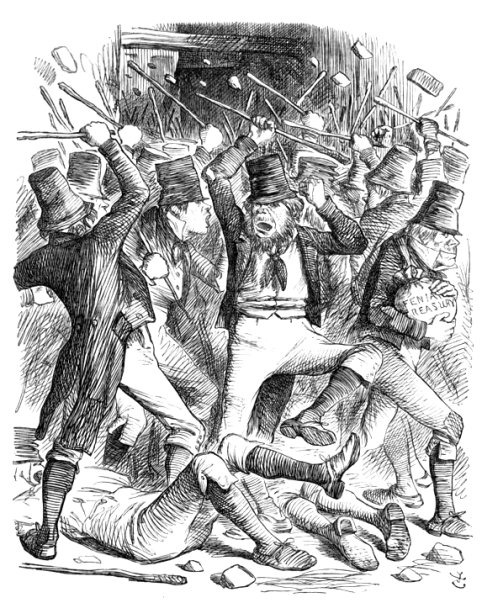

The top one is from 1866, and the second one from 1849. Both were cartoons published in Punch Magazine, which was the pre-eminent social and political publication that EVERYONE read in the Victorian and Edwardian eras. It also played a huge role in shaping social attitudes, and you can see more of its, and others, views on the Irish in these excellent galleries. The rest of the British media was the same - almost universally negative views of the Irish, which filtered across the Atlantic over time. And seemed to be vindicated by events like the 1916 Easter Rising, and before that a long running number of secret societies the British kept discovering, plotting revolution against their rule. The whole ‘kiss me I’m Irish’, dying the Hudson green on St Patrick’s day, ‘omg I love an Irish accent’ thing? Didn’t happen until the latter half, or really the last quarter, of the twentieth century. The Irish were pretty much persona non grata when Sarah was alive. Part of the explanation for this came from the idea that the Irish were a part of a lesser race, their Celtic origins leading to a lack of judgement, predisposition to alcoholism and hotheadedness, and passionate outbursts which meant you needed to treat them more like children. Conveniently enough for the British, this explanation meant you didn’t need to treat your subjects like equals, deserving of the vote, or indeed with anything except violence and condescension. Ha. Funny that.
But anyway, back to America.
Third strike: the Irish were Catholic, as Sarah would have been. Only the very richest in society were Protestant, because they were descended from British settlers. Both the British and the US governments of the time viewed Catholicism with deep suspicion, partly for historical reasons (Martin Luther, 1517 and all that jazz) but ALSO because the Catholic Church remained a vastly powerful institution which could and did command the loyalties of people more than the national government, and this represented a dangerous fifth column within the nation state. Most of north and western Europe was Protestant, unlike the south and east which was predominantly Catholic (with the exception of France. But hey, they’re the French. No big.) so the Irish being 99% Catholic was yet another reason they got lumped in with the other ‘undesireables’.
Not a small part of this was caused by the fact that the Irish had been immigrating to America in vast numbers ever since the Great Famine (aka the Potato Famine/Blight) to the tune of and average of c450,000 Irish per decade between 1850-1900. That is... a LOT. Like, New York’s population in 1890 had only just hit 2.5 million! Ireland’s population TODAY is 5 million! So by the end of WWI, there was already a sense that Too Many Irish were here, particularly since the Irish tended, like most immigrant communities, to move into certain areas in large numbers via family groups and connections. Sarah would have been no exception to this, which I’ll explore more in pt 3 later. It was a very common practice in this period for a man to go to America and work, then bring his family and extended family over. Or for young relations to go and live with family already in America if there was no work in Ireland - which there wasn’t, the Irish economy being subsistence agriculture and not a lot else.
All of this together means that when Sarah arrives in Jan/Feb of 1918? She’d get a pretty rough welcome at Ellis Island (still used for incoming immigrants until new legislation establishing a visa system in 1924 went through and basically made it redundant.) and beyond.
Below is a pic of an Ellis Island arrival card, just because it’s cool:

These tightened restrictions resulted in not just health checks, but intelligence tests and ‘mental fitness’ tests, which if failed, could result in the immigrant being sent back to their country of origin. However, Sarah would have made it through okay, because she had good English, her profession and likely her marriage cert and references from Joseph Rogers’ commanding officer to speed her passage. She may even have had family connections already in New York or America, but for the reasons outlined in my previous post, probably wasn’t in contact with them. Or if she did contact them, was likely to be ignored and ostracised. Because patriarchy, yay.
But ironically? Getting into America was the easy part. I know, I know, unbelievable, especially when you consider she was PREGNANT during this. I mean, can you imagine enduring morning sickness and all the other joys of pregnancy on a boat in the middle of the Atlantic in WINTER, in danger of sinking from a U-Boat torpedo at any moment? Can you? Can you??? Sarah Rogers came up against an immense set of obstacles just to get into America and just fucking ploughed through them like they were tissue paper. Which explains a LOT about Steve Rogers, that’s for sure.
Join me next time for pt 3, where I explore Sarah’s living and working situation after she arrives and we all learn to be even more in awe of how fucking metal she was.
#Sarah Rogers#WAS AWESOME I WILL HAVE NO DISSENT IN THE RANKS#no really#she must have been a fucking BADASS#the early 20th century was not a good time to be a woman#or irish#or pregnant#or a widow#yikes#captain america backstory#steve rogers origin#mcu#fandom meta#character development#steve rogers#wwi#ireland#emigration#america#immigration#and all the fun racism and discrimination THAT entailed
76 notes
·
View notes
Text
When I think about the first time I saw Sailor Moon I can’t remember it clearly, my mom, a big fan, showed it to me when on CHV showed anime, I saw many series at that time, but Sailor Moon had a greater charm. Then, I saw Sailor Moon again from the beginning on ETC, and this time I was in charge of showing this anime to my younger sister. Now, every day I see 2 or 3 chapters of the 90’s series. Looking at it from a new point of view, I can understand much more things than when I was a child and I can understand how this series has been transcendental for so many. It is an icon of gender, feminism and sorority.
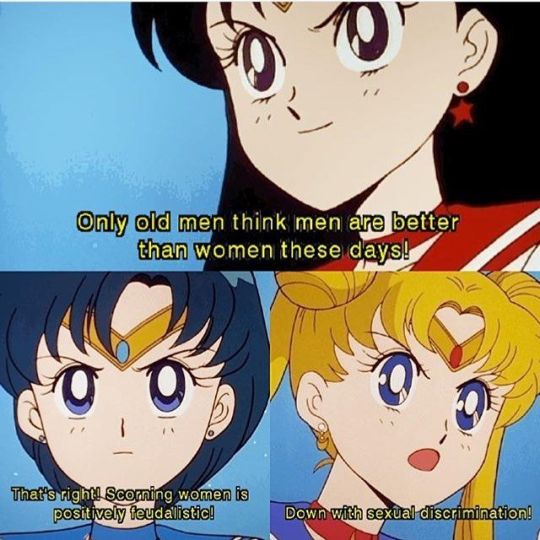
It can be difficult to talk about feminism in Sailor Moon, because many elements of Japanese culture, strongly macho, are visible in the 90s series, the villains, in addition to being mostly women, always attacked young girls in love whose dream was marrying a good man and being a housewife. However, what stands out the most is the fact that the protagonists are strong, independent women who always support each other, many times this thought is overthrown by the Sailor Scouts themselves. Also the fact that they occupy or aspire to occupy all possible places in society, without caring about gender barriers and heteronormativity, and it is common to see reflected through the series many successful adult women, such as the mother of Ami Mizuno who is a doctor or Setsuna Meiou herself.
Within a context not favorable for feminism such as Japan in the 90’s, we find the appearance of manga and anime starring a group of girls who fight for love and justice. At that time there were already anime and movies with female fighters. However, it was always a set of warriors that included one or perhaps two girls with similar characteristics.
At the beginning, each of the protagonists, except for Usagi, are lonely people who live in isolation and face a hard reality, and as they become part of the group, they emerge from these realities and progress to a situation of self-safety. Usagi Tsukino is introduced as a typical girl who goes to school and enjoys with her friends in the afternoons. A particular trait of this girl is that even though she is so young and immature, she wants no one to be alone. It is her empathy and her quality of seeing the best in people, even of her enemies, that I find so touching about this character. Her extreme naivete is what stands out most about her, and I admire how she always hugs her friends or tells Mamoru how much she loves him.
During the series, it is Usagi who finds it most difficult to assume her destiny as a warrior. However, we can see how little by little she begins to visualize it and even being capable to die for her friends and for Mamoru. As the plot progresses, we can see an Usagi more sure of herself and determined, able to face her enemies without hesitation and to express her opinion to others, she is still a girl, of course, but the change is noticeable, compared to the first chapter where she cried about everything and didn’t even want to transform.
The sorority on this group is enormous, when someone sees an injustice, they all support each other. The intimate relationship that the warriors share goes beyond falling in love, that is why they affirm that they do not need boys, since they support each other, fight together, defeat enemies and love each other, regardless of their discussions or disagreements.
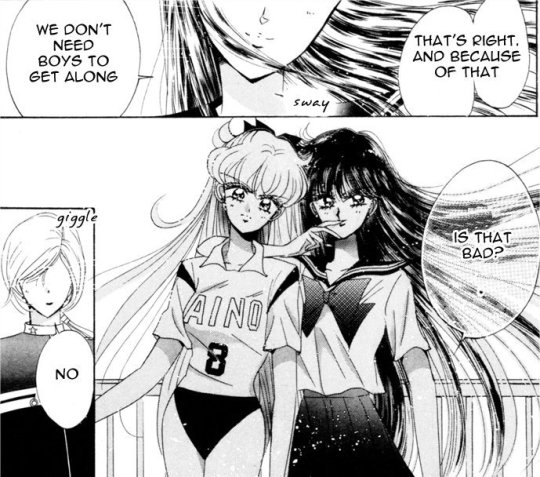
Consequently, they treat each other as allies, friends and sisters, trusting and loving each other as life partners. The representations of love in this anime are also remarkable, Mamoru and Usagi form a mythical couple, their love is so deep that it lasts through the generations and several reincarnations. Many times I read about how Sailor Moon couldn’t do anything if she wasn’t helped by Tuxedo Mask, but I don’t think that was the case. Many times we saw Sailor Moon fighting alone, and although he helped her, there is nothing wrong with it, he always gave her that little push she needed to move forward without fear, a very common topic in the first season but which was decreasing afterwards. Mamoru respects her and sees her as an equal, he recognizes her strength and is not envious of her power.

With love as the base and empowerment as a factor, here enter Haruka Tenoh and Michiru Kaioh, with their relationship that would mark a milestone in the series, where the first breaks with the heteronormativity of the series, presents love beyond heterosexual and other identifications gender that are not cis. The two of them, together with Setsuna Meiou, later dedicate themselves to raising the young Hotaru, forming a small co-parenting family.
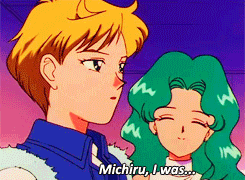
I could also mention the iconic of the series regarding the LGTB+ community, showing us a great sexual diversity, because originally, the character of Zoicite in the manga and anime is male, but due to his homosexual relationship with Malachite, in Latin America and USA he was change for a woman. However, in Latin dubbing, it was the product of an error. Something similar happens with Fisheye, in the Japanese version of the anime and manga, he is gay, however, for the adaptation to English, he was changed to a female character. And the history repeats itself, in the arc where the Sailor Starlights appear, here, they are women, considered by many to be trans, but it would extend me too much.
To finish, these series not only showed us a diversity of characters, genres and sexuality, Sailor Moon also leaves us an important lesson that should never be forgotten: be true to yourself. Seeing again the 90’s series, the phrases that the Sailor Scouts say when they go to defeat the villains makes me noise, and they open my eyes once again, it is important to know that we are enough, we are more than our weaknesses, we are more than our history, ‘cause in the end we can always be a warrior and at this moment, the change in our society, we will achieve together, hand by hand, like the Sailor Scouts.
Isidora Andrade
5 notes
·
View notes
Text

@failured asked: 🔥🔥🔥+ shipping , canon divergence & dealer's choice!
Send me a “ 🔥 “ for an unpopular opinion.

1. Shipping.... Oh boy, where do I begin? We already know it’s a mess lol. I’ll focus on only one, since it calls for it: people need to learn about multishipping. I’m surprised that this feels like an unpopular opinion, but if you do not ship something, that literally gives you no right to attack others for shipping it. For many of the shows we watch, there are no ‘canon’ ships. Popular Ships do NOT equal canon, and if someone doesn’t ship something ‘popular’, then people need to respect that. ( That includes people seeming to literally single people out in order to tell them that you don’t like there ship, and people sabotaging fanart so that it shows the more popular ship instead of it’s original ship. Which does happen. ) This mostly happens to straight ships from what I’ve seen--- a lot of gay m|m ships are what’s most popular, and if anyone ships anything f/m then it’s ‘boring’ and such. ( And we all know it’s because the other half is female. ) Basically, let people ship what they ship. As long as they’re not hurting anyone and understand the dynamics, then leave them alone. It literally doesn’t affect you or your ships.
2. Canon Divergence... @ people who apply canon divergence to their canon muses: LEAVE. CANON. WRITERS. ALONE. I have friends who hate the canon of their respective fandoms, and explain why they do, but they are able to respect other blogs who still stick to canon. ( Or at the very least, leave them alone and don’t seek them out. ) There’s so much ‘I am right!!!’ when it comes to people in this community and their portrayals, and it doesn’t help when they’re backed up by equally ignorant people. Being canon divergent doesn’t make you superior, and it doesn’t mean that you can look down or trash talk on writers who still like canon and stay within it’s lines. My dash is usually free from too much drama because I make sure to follow people who have common sense, but still the overall feeling of entitlement and ‘i’m right’ still leaks over sometimes. And also likewise-- Canon writers leave the divergent writers alone. They have their reasons for not adhering strictly to canon, be it opinions or personal reasons. Just respect opinions and leave it alone.
3. Dealers Choice.... Fandoms are too passive on racism. I’m sure that this might be an unpopular opinion tbh, even if it might seem obvious. I’m not talking about how you should all write muses of color and such, but I just mean your general reactions to subtle racism. Not even obvious racism - which is troublesome in the reactions is given - but the subtle ones. Ya’ll don’t listen to us. When we try to bring attention to someone who seems to be a bit problematic even if it’s lightening icons of a darker skin character, many of ya’ll just call it ‘drama’ and ‘call out culture’ and roll your eyes just because slurs aren’t being thrown. And lbr--- ya’ll look over muses of color like the plague. ( Unless they’re of Asian descent because ANIME!!! and KPOP!!... even though you’re casting Koreans for your Japanese muse. )
#failured#;ooc#; ( answered meme )#// this might seem all over the place and it probably is lolol#honestly i'm just tired#there's too much wrong with fandom/the rpc community#basically--- common sense is an unpopular opinon and ya'll known i'm right xD
2 notes
·
View notes
Text
Seeing the light
5 current and Historical Portrait Photographers
Historical
Richard Avedon

Born in 1923, Photographer Richard Avedon was best known for his work in the fashion industry and for his clean and simple portraits. He worked for the Merchant Marines as a photographer, taking photos for identification. He then moved to fashion, working for Harper's Bazaar as well as Vogue, speaking up about how the models need to convey emotion and movement, a complete contrast from the normal stiff subjects the fashion industry are used to. One of his more ground breaking portraits of the model Twiggy boosted his career as well as his own showing the fashion industry that it doesn't always need to be the same boring old poses.
Annie Leibovitz

Leibovitz is a portrait photographer who in 1970 secured a job at Rolling Stone and went on to create a brand and distinct look for the company living up to the title of chief photographer. She began working for vanity fair in the early eighties, producing images that would be known as iconic and provocative in the future. Having also worked on high-profile advertising campaigns, Leibovitz's images have been showcased in several books and major exhibitions around the world. She is seen as one of the most innovative and iconic female photographers of her time.
Phillipe Halsman
Dali’s Mustache
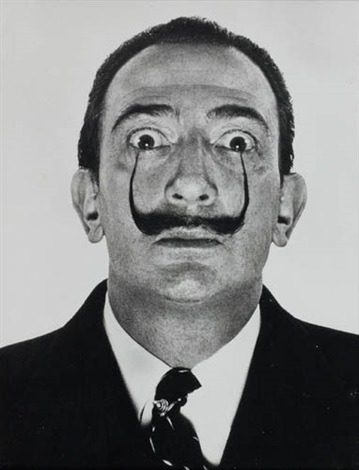
Dali Atomicus

Born in 1906 and died 1979, Halsman was ‘one of the top 10 greatest photographers of all time’ titled by his colleagues from the American Society of Magazine Photographers (ASMP), he started his career in Paris where he opened his own studio photographing famous artists such as André Gide, Marc Chagall, Le Corbusier and André Malraux shooting them using his own design of a twin-lens camera. In 1940 he moved to America for a intervention of Albert Einstein creating an iconic photo of the scientist. One of his main collections that he has created was over a thirty-seven year period with Salvador Dali which produced interesting images including ‘Dali’ s Atomicus’ and ‘Dali Mustache’.
Diane Arbus

New York born photographer Diane Arbus is known for compelling often disturbing images of the not so normal population of that era. She started photography by taking advertisement photos with her husband for her parents business, however soon transitioned into commercial fashion photography for Harper’ s Bazarr, show Esquire, Glamour, The New York Times and Vogue. Although she loved the fashion industry it wasn't her passion so she stopped shooting commercial fashion and decided to concentrate on fine art fashion photography, through this Esquire published her first photo-essay and from there she started free-lancing and instructing making a living off the art she made, focusing more on the peculiar side of portraiture she shot more interesting people such as transvestites, nudists, ‘dwarfs’ and mentally and physically handicapped people.
Edward Steichen
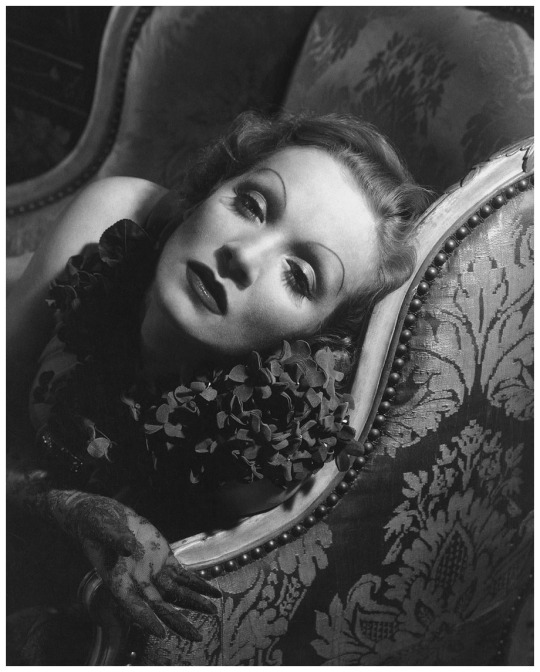
Steichen is famous for his fashion photography within the 20s, He was approached to be chief photographer for Conde Nast which he then pursued for 15 years, however he had been an artist and photographer for a multitude of year before, within that period of time he met many people such as Clarence White and Alfred Stieglitz who have helped him through his career. During the early 1900 he directed aerial photography for the Army Expeditionary Forces, continuing with the forces after his leave from Conde Nast as he became a Lieutenant commander in 1942 and led a successful photographic institute.
Current
Steve McCurry

McCurry born in Philadelphia, after graduating he joined a newspaper for two years before venturing to India to do free lance sparking a interest for international countries and the conflict that stems between countries. After his images from the conflict going on inside Afghanistan (before the Russians invaded) came out he received a Robert Capa Gold Medal for Best Photographic reporting from abroad to congratulate him on his bravery. Steve McCurry has received numerous amounts of awards such as Magazine Photographer of the Year, awarded by the National Press Photographers Association and he has also won the Olivier Rebbot Award twice. McCurry focuses a lot on the human consequences of war as well as covering many civil conflicts around the world. His most famous image is of an Afghanistan girl which has been titled the most recognized photograph in the world today.
Jimmy Nelson

Nelson was born in Kent in 1967, he goes by a photojournalist and photographer and is known for his tribal portraits and indigenous peoples. He started doing photography in 1987 and after spending a decade in a boarding school he decided he wanted to challenge himself, so he decided to travel across Tibet by foot, which lasted a year, and by his return the diary and photographs he produced showed part of Tibet that no one would of seen before, these were also published to international acclaims. After this break through he was commissioned to do a multitude of different controversial topics such as the Russian involvement in Afghanistan. Since 1997 Jimmy began to successfully take commercial advertising assignments with top brands, as well as accumulating unique cultures with his traditional 50-year-old plate camera. Jimmy decided he wanted to travel the world and show us what kind of cultures we’ve pushed to the side and ignored, he has seen so many cultures and tribes such as Goroka and Kalam in Indonesia and Papua New Guinea, Tsaatan in the remote subarctic taiga of Mongolia and Mursi in Ethiopia these are only a small amount of where he has been.
Lisa Kristine

Lisa Kristine is an internationally recognized fine-art photographer, humanitarian, activist, and speaker. For more than 30 years she has documented indigenous cultures and social causes in more than 150 countries, meeting people and treating them like they've known each other for years even though they've never met. Lisa’s work has been shown in exhibitions and purchased for permanent collections in museums throughout the United States and other nations. The symbolism that flows through her work defines Lisa's beliefs that all human begins are equal and worth the same. Kristine uses the subjects emotions and enviroment to map out the image and spread awareness about serious subjects such as human trafficking.
Jingna Zhang
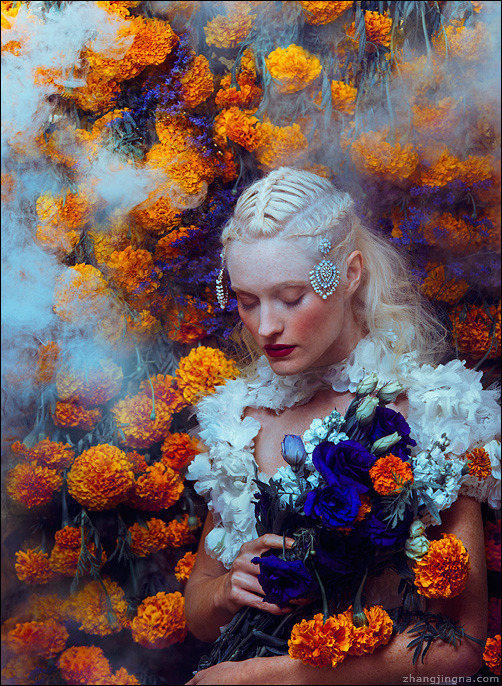
Zhang was born in Beijing and rasied in Singapore, she is a Fashion, Fine art photographer as well as director based in New York. She is influenced with love for the Pre-Raphaelites and Japanese anime, she also mixes Asian asthetics with western art styles and creates a beautiful mix that compliments each other. Jingna’s works have appeared on multiple editions of Vogue, Elle, and Harper’s Bazaar. Her clients include Mercedes Benz, Montblanc, and Lancome. Jingna’s fine art works have exhibited at Leica Gallery Milan, Tsinghua University, and Japan Creative Centre in Singapore, and she has spoken at Laguna College of Art and Design, Monterrey Institute of Technology, and Square Enix.
Manny Librodo
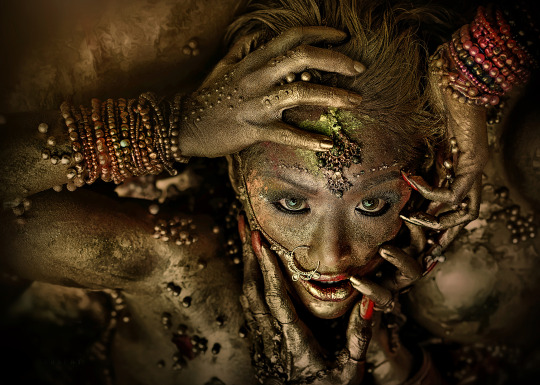
Manny was Born in 1964 in Lambunao, Iloilo, Philippines, he graduated and became a high school teacher before becoming a photographer. However, now he is a extremely popular portrait photographer know for being highly decorated and very popular within the photographer community. His work has been seen in Asian geographic and calendars for UNICEF, apart from actually taking the photos he is a high-sought photography mentor as he has amazing technical skills and is so well adapt to photography as he has been all over the world collecting information that he can then pass on to other to give them knowledge.
4 notes
·
View notes
Text
‘Black Mirror’: the dark side of technology
by Oihab Allal-Chérif
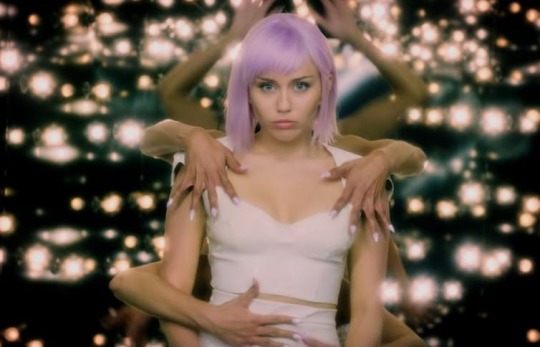
Season 5 of Black Mirror begins on June 5, 2019. Allocine
(translated from French)
Because technology as its main character, Black Mirror is one of the most fascinating yet disturbing series of the last ten years. Fascinating, because viewers can easily identify with most situations. Disturbing, because the technology is hostile: addictive, invasive, spy, alienating, psychopathic, apocalyptic… Since Netflix broadcast the trailer for season 5 of Black Mirror on May 15, to launch on June 5, viewers have been eagerly awaiting the series, which, in very few episodes, has inspired the public, and many other shows.
youtube
Black Mirror season 5 trailer.
An original concept for a powerful message
Launched in 2011, Black Mirror not only aims to entertain, but it also invites us to think about how technology can harm society and transform our behaviour. Each episode shows how an existing technology could evolve in the near future, for better, or especially for worse. Technology can be dangerous in itself, but more often malicious designers or users use it to manipulate, humiliate, coerce, enslave or kill.
In Black Mirror, the situations are familiar, but are pushed to the extreme, provoking anxiety, destruction and even death. Each episode is independent, with its own universe and style, though clues sometimes link them. The topics covered include the obsession with celebrities, reality TV, social networks, video games, smartphones, and pornography; the end of private life; robots and androids; social and commercial profiling; fake news and opinion manipulation; dating sites and matching systems; immersive augmented reality; cybersecurity and cyberbullying; the transfer of memory or consciousness into a machine; and transhumanism.
One of the most iconic Black Mirror episodes is season 1, episode 2, “Fifteen Million Merits”. It presents a world close to the description of philosopher Herbert Marcuse, in which humanity is enslaved by mass media, advertising and industry. The main character, Bing, spends his days pedalling an exercise bike in front of a television screen, like the whole of the middle class. He earns credits, called “merits”, to buy products or services. In this materialistic society, where technology dominates and corrupts, everyone is constantly being filmed. Reality TV and gaming are the only entertainment, and fame the only ambition. Not using pornography is a crime. Although Bing wants to revolt and denounce the system that oppresses him, he eventually becomes part of it, abandoning his morals for a comfortable life.
youtube
The most powerful moments in Black Mirror, episode “Fifteen Million Merits”.
From horrifying science fiction to tragic reality
While Black Mirror seems to unfold in the near future, the show depicts worrying current trends. Its creator, Charlie Brooker, surfs the technological news, cleverly incorporating it into terrifying scenarios. While these fantastic stories may seem exaggerated, technology, particularly digital technology, is increasingly used in crime, is responsible for multiple pathologies, and causes geopolitical conflict, the drift toward authoritarianism and social deterioration. Black Mirror prophecies that have come true are the subject of heated debate.
The perverse behaviour presented in several episodes of Black Mirror can be observed on social networks. On May 15, a 16-year-old Malaysian teenager committed suicide after asking her Instagram followers if she should live or die, because 69% told her to end her life. Facebook has also been blamed for broadcasting live 17 minutes of the March 15 attacks in Christchurch, New Zealand in which 51 people died. Black Mirror repeatedly illustrates the morbid, sordid tastes of many anonymous online viewers, as in the very first episode.
youtube
Black Mirror, trailer for the “National Anthem” episode.
A futuristic show that questions the present
Season 3, episode 1, “Nosedive” describes an oppressive society where everyone constantly grades other people’s words, actions, and publications on a five-point scale. They are equipped with eye implants enabling them to see the grades of those around them. This satire on a society where everyone is obsessed by their own image criticises superficiality and the need to portray oneself positively to obtain other people’s approval. The episode illustrates perfectly the consequences of China’s “social credit” system, which monitors and records the entire population in real time to “improve” behaviour and strengthen the regime.
In season 3, episode 2, “Playtest”, a gamer tries an experimental video game that kills him in a few milliseconds. The guinea pig is equipped with a virtual reality headset and a neural implant. The implant hacks his brain and generates images based on his fears and physiological data. The episode warns against giving developers control of human senses, and about the immersive, invasive technologies that are the future of video games. “Playtest” was first broadcast on Netflix on October 21, 2016, a few months after the release of the Facebook Oculus Rift Headset on March 28, 2016.
Season 4, episode 5, “Metalhead”, describes a post-apocalyptic world, where intelligent killer dogs hunt humans. This is a direct reference to the company Boston Dynamics, which Google sold in 2017 to the Japanese group Softbank. In the series, these dogbots appear on building sites and in public, but the project was initially a partnership with DARPA (Defense Advanced Research Projects Agency), a US military R&D agency.
youtube
Fiction: special effects in the Black Mirror episode “Metalhead”.
youtube
Reality: Boston Dynamics robot testing at construction sites.
Imitated but never equaled
The Season 5 promotional campaign reminds us that the series has changed its viewers’ perceptions of the world and has received multiple prizes, including Emmys and BAFTA Awards. The reviews are excellent, with an overall score of 8.9/10 on IMDb.
Similar shows have tried to imitate the success, such as the miniseries Electric Dreams, based on sci-fi author Philip K. Dick’s short novels, many of which have been adapted for the screen. Considered a clone of Black Mirror, Electric Dreams was first aired on Channel 4 in Britain, like its model. Amazon Video acquired the US rights, and with Bryan Cranston as executive producer and an all-star cast, the series was successful, but did not attain the cult status of Black Mirror.
Westworld also seems strongly influenced by Black Mirror. Its first two seasons focused on robotics and transhumanism. HBO has just released the trailer for the third season, planned for 2020, in which a new character, played by Aaron Paul (who played Jesse Pinkman in Breaking Bad, and who performed a voiceover in an episode of Black Mirror) condemns the false promise of a better world made to justify the technological development and commercialisation of servo devices.
Black Mirror has often been compared to The Twilight Zone in the 1960s, and is probably at the origin of its reboot, although the showrunner Jordan Peele – author, director and producer of the thrillers Get Out and Us – denies the similarity. Jordan Peele is also co-author of the series Weird City, released on February 13, 2019, on YouTube Premium. Its well-chosen guest-stars present the dangers of technology with more humour.
AMC, which broadcast popular series like Mad Men, Breaking Bad and The Walking Dead, has commissioned a new series for 2020 from Will Bridges, one of the authors of Black Mirror, that will focus on a dating technology that finds your soul mate. Since the original is often better than its copies, let’s hope that Netflix will produce many more seasons of Black Mirror.

About The Author:
Oihab Allal-Chérif is a Full Professor of Information Systems, Purchasing and Supply Chain Management at Neoma Business School
This article was republished from our content partners at The Conversation under a Creative Commons license.
#science fiction#science fiction and fantasy#scifi tv#Netflix#Black Mirror#black mirror season 5#technopolitics#social media#scifi in society#featured
7 notes
·
View notes
Text
Digital Kanban Boards Can Assist the Manufacturing Refine
In a time when production processes and monitoring systems are indicated to reduce the cost of production, we are coming out with new as well as cutting-edge modern technologies to do simply that. A digital Kanban board can aid makers, retailers, and every other field of the business world that has jobs, procedures, and manufacturing cycles keep an eye on their production and minimize their prices while doing it. Kanban Coaching
Before exploring exactly how these electronic boards are helping manufacturing processes, we initially need to review specifically what a Kanban system is. Kanban is a system created in Japan in the 1940s that was meant to associate lean manufacturing, specifically through making a graph of the manufacturing procedure, as well as developing activating events at which particular points would happen. This took all of the guess-work out of the production process. Rather than considering stock and also making or getting even more when it looked low, a company would certainly mention outright that when stock struck 300 devices, manufacturing would continue as well as bring back the stock degrees. Furthermore, if supply went over a certain top bound, after that production would certainly stop until degrees were lowered to the lower limitation.
Firms still use this system of lean manufacturing and the Kanban approach today. Nonetheless, with manufacturing degrees a lot higher than they were in the middle part of the century, we are facing troubles of recognizing exactly where we are in the production procedure. It is tough to have a person go and count inventory degrees, and also existing ERP systems are not established up to produce aesthetic displays of when we require to obtain more stock or require to halt production. This is where the electronic aesthetic Kanban systems come into play Free Kanban Board.
These digital systems resolve on the internet platforms that allows just about any individual that needs the info to be able to discover it. Boards are set up to show precisely where manufacturing as well as the procedure is. Special screens, icons, as well as charts can be contributed to produce additional understanding by a variety of various customers, and firms can transform the boards to fit their manufacturing requirements and also diction. This ensures that the system works equally as it is intended to for every private business.
Visual Management Solution as well as Software
Using visual management systems is a reliable method for companies to deploy information without making use of created guidelines. It is a prominent strategy that makes best use of the quality as well as effectiveness of their communication via aesthetic signals. Visual signals enable the customer to comprehend irregularities, problems or deviation from common processes at a glimpse.
Utilizing aesthetic signals in contrast to condition reports creates a faster feeling of urgency.
It can be frustrating filtering with text simply to locate a specific item of important information. As an example, if a web site's user interface fails to deliver ease as well as performance on a consumer's mobile phone, numerous bucks in shed sales could result. Nonetheless, site issues like these can be rapidly recognized and attended to when a company utilizes aesthetic signals Free Kanban Board.
A popular joke phrase that summed up the miscommunication that occurred within a firm was, "Didn't you obtain the memorandum?" Management via visual signals produces a more efficient operating organization since it merges interaction between various divisions. Also one of the most well organized people quickly experience difficulty staying on top of a task's condition as changes are updated in their inbox, documents folders as well as spread sheets. When staff members utilize the aesthetic task monitoring device, it allows them to focus on and also focus on their small and also larger jobs as well as remain concentrated working with other staff member who might require to see their job. If a company's group is currently spiraling out of hand and also requires to reach their complete possibility, visual system control can assist in the following means:
- It promotes continuous team cooperations
- It motivates the group to function better as an unit
- Task supervisors invest much less time tracking information when they manage work visually
- It produces a better atmosphere as staff member obtain jobs with much better clarity
The white boards is the most preferred standard tool for visual administration. The electronic variation of a whiteboard can be utilized as a job board, Kanban board or taskboard depending on whether the group wishes to utilize it to conduct everyday condition meetings or provide a quick distribution of work-in-progress to elderly managers or firm leaders Free Kanban Board.
Exactly How to Improve With Kanban?
Kanban is a certain agile method that is gotten in touch with Japanese organization approach. Its suggestion was to start with executed on the task of grocery stores. But now the Kanban is effectively carried out in software application screening field.
Kanban pictures the range of work and also streamlines its perception. A great deal of looks into have actually proved that people view and bear in mind the picture aspects quicker than the message. This methodology can be applied with the aid of several points Complimentary Kanban Board.
What Is Necessary for Kanban?
Marker
Sticky notes
Board
A certain task is created on the note. All such cards are put on the board. In the procedure of task execution, the cards pass a number of phases before they will be closed. For instance, for functional screening there might be such columns as 'to do', 'doing', 'waiting' and also 'done'.
There are a number of principles of the Kanban method which were developed by David J. Anderson.
What Are the Kanban Fundamentals?
Continuation the existing procedures. It is worthless to reinvent the wheel. In spite of the version of software growth, Kanban has the ability to effectively communicate with the in-process job.
Execution of adjustments. Normally, conceptually brand-new adjustments are ineffective for the long-lasting tasks. But Kanban makes the processes extra flexible and makes sure a smooth operations.
Conserving of the existing duties as well as obligations. Psychologists have actually proved that individuals hesitate of adjustments. That is why it is not suggested to change the employees' functions from the very start.
The Kanban principles will help to supply a reliable checking of the item under test. Its approach infers the maintaining of some actions Free Kanban Board.
What Are the Kanban Process Tips?
Visualization. It is much better to make a map for the primary processes and also project areas. In such an instance, the entire scope of job will certainly be conveniently comprehended.
Limitations. A particular jobs need to be restricted to ensure its correct execution.
Circulation monitoring. The state period of every card must be gauged. The professionals require to regulate the transitions of cards in between this or that state.
Explicit definitions. There must be a complete understanding of functionality of the product under test.
Versions and also approaches implementation. A lot of different operations designs are readily available. They will certainly help a tester to begin the fulfilment of assigned tasks.
Kanban ought to not be used just theoretically. It has numerous ways of application. Trello is just one of them. It is a totally free monitoring tool for different jobs. Trello is extensively made use of in software application screening company. A tester may develop a number of boards for sure system elements or projects. The professionals include the cards with appointed tasks and also comment them to keep other team members aware of the task status Free Kanban Board.
The administration of mobile testing, web site screening or game screening ends up being simpler as well as more outlined with the assistance of implied Kanban principles.
Exactly How Can a Digital Kanban Board Adjustment Your Life?
Company is the key to success when engaged in any sort of project. In most cases, individuals and also organizations do take actions to prepare and arrange their progress as it takes place. However, people often undervalue their real requirements when it pertains to administration and also company, falling short when it involves communicating and also keeping goals plainly specified. A brand-new growth in management and organization techniques is in fact decreasing the number of challenges that prevent jobs while additionally boosting success throughout the board. Aesthetic administration devices clarify the development procedure for jobs of any kind of range and also define the success of group initiatives more clearly for all events involved. There are a wide range of visual management devices that are conveniently available with each one supplying some really real advantages Complimentary Kanban Board.
Aesthetic tools such as these minimize the amount of time you purchase a task by making the intricate simple. Simplification enables people to focus on tasks and absorb much bigger quantities of information in a single glimpse. When communication is boosted through much more efficient preparation and company devices, you also decrease the amount of waste that you generate trying to obtain suggestions, progress reports, and also various other data bent on employee. Collaboration has actually likewise confirmed to be an integral component of success for projects in virtually every sector. Visual tools are easily shareable, leading to better team effort due to the truth that everyone included can quickly grasp what other companions are adding towards the success of goals.
What Is Kanban?
Kanban is a core component of the Lean producing movement made very popular by a couple of intense supervisors at Toyota. The dad of this revolutionary management assuming at Toyota was Taiichi Ohno. His work around systems assuming was described Toyota Production System and later renamed Lean Production.
Kanban simply refers to a signboard or taskboard or signaling board that tracks WIP or "Operate In Progress." In making the WIP idea is part of the value system described within the six "Toyota Rules." One of those regulations explains keeping inventory or quantity amounts at "just sufficient" or "Just in Time." Although Kanban was originally slated for the production sector considering that 2007 Kanban has actually expanded significantly in the software program growth market many thanks to a number of idea leaders including Mary Poppendieck that popularized a few of the core parts of Lean Production in her talking and also writing. Software growth assumed leaders have asserted that software application developers can manage the quantity of work that they are servicing - typically denoted as organization need specs (BRS) or software need specifications (SRS) or user tales at any given time by implementing a Kanban taskboard. Software program developers can see as well as respond to how much work they have begun, how much job they have in progress, what work is currently impeded as well as how much work has actually been finished. The Kanban taskboard, whether electronic or physical, can be set up to not just manage this operate in development, but likewise supply automated cues to various team members. Teams can also add metrics to track the variety of BRS or SRS or customer tales they contend various cycles throughout a job Free Kanban Board.
Although Kanban assures much less than the a lot more extensive and disciplined technique of Scrum or Scrum & eXreme shows (XP) working together, Kanban has actually become rather prominent as a result of its simplicity of implementation and also absence of business interruption (which surprisingly lots of additionally see as its Achilles's heel). If it's so easy to execute and also not triggering an interruption opportunities are that it isn't doing sufficient to transform the globe of job.
Is Kanban part of the dexterous software program advancement movement? There are supporters on both sides of this disagreement. Those in favor see Lean being action in action with Agile and also see Kanban as an implementation of the Lean system just as Scrum is an execution of the Agile software application growth activity. And after that there are those that get on the opposite side of the formula and they see the ability for teams to take on the methods and procedures of Kanban without needing to execute the worth systems of dexterity as ruling it out of the Agile movement. According to Ken Schwaber (co-founder of Scrum) Scrum's duty is to appear group and business based dysfunction. Kanban doesn't have the ability to surface organizational and group based impediments so one can say that Kanban does not meet the core value systems that are described in the Agile Manifesto or in the Scrum Guide. This suggests Kanban is easy to apply yet Kanban's results can be really small or short-term.
For those people that are Scrum professionals would certainly tell teams to begin with Scrum or XP or both if you intended to obtain one of the most transformative advantage. Just using Kanban as a fallback setting - for instance in cases or atmospheres where surfacing disorder is frowned upon by top monitoring Free Kanban Board.
Although prominent and also easy to implement do not be fooled in assuming Kanban on its own can provide the exact same degree of makeover that a Scrum & XP application can provide. If utilized appropriately Kanban can be a fantastic access factor for an organization to contemplate different types of process without having to jump head first right into the deep end - if nonetheless your software development teams are ready for an overall improvement aim to carry out Scrum & XP instead.
0 notes
Photo
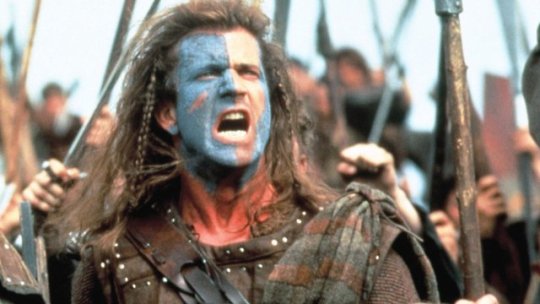
Braveheart (1995)
The summer of 1995 provided moviegoing audiences with a third Die Hard movie, Casper, batnipples, Disney’s problematic Pocahontas, Apollo 13, Waterworld, and one of the most understanding children’s films of all time in Babe. That is a busy summer to say the least. Amid that clutter, one of the most successful movies of that period could not possibly have been made now, let alone find the audience it did twenty-three years ago. Released by Paramount in North America and 20th Century Fox internationally, that film is Mel Gibson’s Braveheart, a thirteenth-century war epic about Scottish knight William Wallace (played by Gibson) taking arms against King Edward I of England in the First War of Scottish Independence. Braveheart was Gibson’s second directorial work after more than a decade as a figurehead for 1980s Australian cinema and presence in the Lethal Weapon series. This is a visually striking, technically accomplished film rife with homophobia, misogyny, and historical howlers that continues to sharply polarize viewers about its cinematic merits. Through the fires of these controversies, the extremely violent Braveheart has bludgeoned its way to becoming an iconic fixture of 1990s Hollywood.
It is 1280 in Scotland. As a child, William Wallace survives King Edward “Longshanks” (Patrick McGoohan) invasion of Scotland. Following Scottish defeat, Wallace is taken on a European journey by his uncle Argyle (Brian Cox). Years later, Wallace (Gibson as an adult; James Robinson as a child) will return to his village and marry childhood friend Murron MacClannough (Catherine McCormack as an adult; Mhari Calvey as a child). But Longshanks has granted his English nobles in Scotland right of the first night, and Wallace’s successful attempt to save Murron from rape eventually ends in her execution. Enraged, Wallace – assisted by his fellow villagers – massacres the English forces sent to his hometown and drives the remaining English military from Scotland. Longshanks will not take military defeat without response, ordering Prince Edward (Peter Hanly) to quash the rebellion. War and royal intrigue breaks out, leading to Edward’s wife, Isabella of France (Sophie Marceau), being sent to negotiate with Wallace and the two falling for each other far too quickly.
With that plot in mind, viewers should understand that the only historically accurate aspects of Braveheart are the names of the historical figures involved and place names – really, that’s it. The Scots wear kilts, despite the fact kilts would not be invented for another several hundred years. If one wants to understand the First Scottish War for Independence and the history surrounding this era, read a book instead. Screenwriter Randall Wallace admitted that his script was based less on history than on the epic poem The Actes and Deidis of the Illustre and Vallyeant Campioun Schir William Wallace, written by Blind Harry in the fifteenth century.
In its medieval swordplay, Braveheart has more to do with Spartacus (1960) than anything in a 1930s-40s 20th Century Fox or Warner Bros. swashbuckler. The film’s enormous battle scenes – shot in Ireland with over 1,500 members of the Irish Army Reserve participating on both sides of this cinematic conflict – are excellent collaborations in deploying men on foot and horseback smashing into each other on a grassy plain with a frantic camera attempting to make sense of the scrum. The use of 200-pound mechanical horses running on nitrogen cylinders even fooled an animal welfare organization that decided to investigate the film because of the effect’s realism. When not indulging in ill-advised slow-motion, these battles, perhaps too frequently placed into the film to the point they becoming fatiguing, are spectacular in their choreography. The collaborative effort between Gibson, cinematographer John Toll (1994′s Legends of the Fall, 1998′s The Thin Red Line), editor Steven Rosenblum (1989′s Glory, Legends of the Fall) and second unit crew members contributes to a blood-soaked, crashing symphony of mangled limbs and human brutality that no other film depicting medieval warfare has since equaled – especially the Battle of Stirling Bridge, which is horrifying in its impact despite the absence of the crucial, eponymous bridge. Many films since Braveheart portraying contemporary war likewise pale in comparison.
Braveheart would be a disastrous film without John Toll’s cinematography, whether in action sequences or peaceful moments. The use of natural lighting and the on-location shooting in Ireland and Scotland appeals to Toll’s strengths for exterior shots, lending Braveheart a near-mythical angle amid large landscape shots blessed with eerie cloud covers and looming, verdant mountains. Toll makes Scotland a place of dreams – especially in the blue of twilight when the sun’s reds have retreated westward, welcoming the cool and comfort of the evening. This suits the film, as Gibson is not filming a historical drama. No computerized flourishes or too many swooping helicopter-aided vistas pry the viewer from the film. Toll’s camera for these landscapes and shots of the village (reportedly built by the production crew to Toll’s specifications) remain still or are gently heightened or lowered by crane shots. Close-ups are mercifully spare, reserved almost entirely for violent scenes.
The word “freedom” is tossed around with such promiscuity and depthlessness that Braveheart’s 178 minutes cannot be justified. Wallace’s screenplay touches lightly on the era’s politics, Wallace’s love life, and the ideas why Scotland should be independent from England. Political philosophy this is not. Look elsewhere for films of military leaders with a wracked conscience, psychologically impacted by the slaughter they have initiated. Instead, we are presented with anachronistic dialogue like this:
WILLIAM WALLACE: Before we let you leave, your commander must cross that field, present himself before this army, put his head between his legs, and kiss his own arse.
Sure, dude. If possible, maybe that commander might have a future as a contortionist.
Braveheart presents William Wallace as a man on a revenge-fueled mission who will consider all possible means to liberate his people – he has an irreverent sense of humor that makes given scenes a tonal mishmash. Wallace’s romantic interludes with Murron and Isabella? Gibson, McCormack, and Marceau, respectively, are all unconvincing – despite an enormous assist from Toll in these passionate scenes.
Casual homophobia is directed toward Prince Edward (later King Edward II), the son of Edward Longshanks (Edward I; who was a bellicose monarch, but becomes a cartoonish archetype in this film). Prince Edward is depicted as effeminate and gay, and his lover Philip (Stephen Billington) is killed by defenestration. The film further compounds this depiction by associating the Prince’s homosexuality to his ineffectual character – Longshanks constantly chastises his son’s lack of masculinity and Princess Isabella also disapproves of her husband for those qualities. This is not to say homophobia did not exist in the late thirteenth century, but that Gibson and Wallace are doubling down on the Prince, making him a punchline puppet of a leader because of who he is. Aggressive masculinity and sexual expressions inundate the battle scenes, too – swinging swords should be interpreted as one might think.
Women have almost zero agency in Braveheart, as they are depicted as sexual vessels to remain pure and chaste while the men fraternize and fornicate all they wish. Wallace’s campaign of violence begins not because the English lords have invoked right of the first night (prima noctis) for other women, but because prima noctis has been invoked for Murron (whose sexual faithfulness is idealized after her death in a pair of visions Wallace – who, by sleeping with Isabella, does not return that same faith – has). One of the few topics that women speak of throughout the film is sexual interest/satisfaction or lack thereof – Isabella’s only purpose in the film is to bang Wallace so that she can deliver an inflammatory piece of news to Longshanks on his deathbed.
Other than Toll, another craftsperson showcases their mastery in this film. That master is composer James Horner (Glory, 1997′s Titanic). 1995 proved to be a career year for Horner, having composed the scores for Apollo 13, Balto, and Casper. His second-best score of the year behind Apollo 13, Braveheart’s score is mostly devoid of the wanking masculinity described above, combining cultural elements that might seem inappropriate for a film about Scottish warriors – given the use of Japanese woodwinds in Legends of the Fall (a generational epic drama about a Montana ranching family), Horner’s instrumental appropriation knows no bounds, for good and ill. Along with the requisite bagpipes (rather than the Great Highland bagpipes that are generally associated to be “bagpipes”, Horner utilizes Uilleann pipes – Irish in origin, Uilleann pipes are softer and considered to produce a less harsh sound than Great Highland Bagpipes), this heavily orchestral score also benefits from a boys’ choir reminiscent of Casper, Horner’s affinity for Irish music, and quena (an Andean flute) for “The Secret Wedding”.
Three major motifs exist in Horner’s score: for Wallace, Murron, and Isabella. Wallace’s motif is first in the main title through the Uilleann pipes and will be the most-repeated theme in the film, fragmented up by percussion in the battle scenes, and often accompanied by strings in melodic unison (most heroically at 6:05 in “Freedom/The Execution Bannockburn”). Murron’s motif assumes melodramatic, (and very quickly afterwards) tragic connotations upon its most memorable appearance on quena in “The Secret Wedding”, chorally reprised at 3:10 in the “End Credits”. Dominating the final third of the film is Isabella’s motif, best outlined in “For the Love of a Princess” by the entire orchestra, and containing echoes of “The Ludlows” from Legends of the Fall. Credit the London Symphony Orchestra for providing a gorgeous recording, even if Horner’s score to Braveheart is not the most musically interesting effort of his career.
Producers Bruce Davey (Gibson’s longtime producer) and Alan Ladd, Jr. (son of legendary Paramount contracted actor Alan Ladd) navigated numerous obstacles at 20th Century Fox and Paramount to complete the film. This enormous, nearly three-hour production of a time period unfamiliar to North American moviegoers could not be produced at this scope today. A 2018 Braveheart would require even more major studios from various nations to finance the project, as epic films have all but disappeared from the multiplex because of their forbidding costs and lack of action star/superhero connections. Gibson’s ambition is staggering here. Yet Braveheart is let down by Gibson’s hypermasculinity and homophobia – reflective of his troublesome political dimensions.
The film’s cultural importance when it was released is unquestionable, but it remains to be seen how time will treat Gibson’s directorial breakout work. By being released in the mid-1990s, it is among the last Hollywood epic films largely untouched by excessive CGI – the effects are gruesome because they are practical. Though the characterizations are simplistic, Braveheart is an effective character piece for many, if not for this writer. Caught between the praises of fanboys of a certain demographic and those who loathe Gibson and/or Braveheart, I can neither adulate nor dismiss this movie outright. Bring on the insults on my manhood, but say it with a Scottish accent, would you kindly?
My rating: 6.5/10
^ Based on my personal imdb rating. Half-points are always rounded down. My interpretation of that ratings system can be found here.
#Braveheart#Mel Gibson#Sophie Marceau#Angus Macfadyen#Patrick McGoohan#Catherine McCormack#Brendan Gleeson#Peter Hanly#James Robinson#Mhairi Calvey#Andrew Weir#Randall Wallace#John Toll#Steven Rosenbaum#James Horner#Alan Ladd Jr.#Bruce Davey#TCM#My Movie Odyssey
2 notes
·
View notes
Text
[tie_index]Intro[/tie_index]
[dropcap]C[/dropcap]oming off the back of the infuriatingly mediocre The Caligula Effect on the PS Vita, Japanese developer, Furyu and SEGA/Atlus brings us The Alliance Alive for the Nintendo 3DS – a Japanese RPG with more to it than meets the eye.
It’s fair to say that I was more than surprised by what The Alliance Alive offered in terms of both story and gameplay and it’s a welcome JRPG title for gamers (like me) who don’t often enjoy turn-based titles, such as Final Fantasy or Phantasy Star.
[tie_index]Straight in with the adventure[/tie_index]
Straight in with the adventure
Some JRPGs can spend hours just starting the game, but thankfully The Alliance Alive wastes very little time presenting the main characters, introducing you to the world and the key plot points.
There is a unique hierarchy in the world: creatures called ‘Daemons’ are the ruling species, in control of the ‘Beastfolk’, who, in turn, dominate and supress the lowly humans of the lands. This hierarchy came about after the Daemons waged war against the humans and, being a superior species, won.
After the war, the world was split into different realms, with a magical barrier called the ‘Dark Current’ preventing humans from travelling to the different lands and only Daemons, who live high above the main lands have the ability to travel between the realms.
Our main story begins approximately 1,000 years after the war, in the town of Svalna, where we are introduced to two young characters, Galil and Azura. This part of the world is constantly raining with the blue skies of previous times just stories of legend (no, seriously), it is also here that a rebellion is forming against the Beastfolk ruling the land, with Azura’s father, Wyatt, at the forefront of the uprising in the region.
After the quick introductions to the story and a handful of characters, you are thrown into the game and sent out on an adventure, in part because Azura has heard tale of a painting of the mythical blue skies being hidden away in an ‘Ancient Museum’ close to Svalna. From here the story develops and throws out some pretty decent curveballs.
Ultimately your rebellion comes down to finding out how to dissolve the magical barriers across the world, defeating some particularly tough Daemons, Beastfolk and monsters, and forming an alliance with humans from the different realms.
[tie_index]More than meets the eye[/tie_index
While I was disappointed with Furyu’s previous title, The Caligula Effect, the game did have some cool features and I’m really happy to see the developer bringing them across to The Alliance Alive.
More than meets the eye
The Alliance Alive intrigued and entertained me more than I expected. From screenshots it’s easy to be deceived into thinking that this is a child’s game, but it’s complex enough to hold older gamers’ interest, while not taxing enough to be confusing or long-winded. It tackles its content with a lot of humour and also focuses on some darker undertones, while character interactions and developments are more entertaining than quite a few RPGs I’ve played.
Side note: There’s a really creepy/weird bit where you go into a house and talk to some kids and they basically tell you that their dad has been physically/verbally abusive since their mum left… WTF?
While Galil and Azura are possibly seen as the main heroes of the game, you are introduced to other groups of protagonists, from very different backgrounds and have a different look on the world, who ultimately find their stories/destinies converging with that of Galil and Azura.
One of these groups features a high-ranking Daemon, Vivian, her Daemon bodyguard, Ignace, and Tiggy, a human scientist, who are all working together to solve the mystery of the barrier separating the world. It’s through this party we learn that not all Daemons are monsters who want to dominate other species, but they want peace for the world.
In another group, we have two humans, Rachel a mercenary who has been hired by Gene, another human actually working for the Daemons. Gene feels there is no need to fight their rulers and does their bidding in a hope to bridge the gaps between their races. With Gene, there’s a begrudging trustworthiness with the Beastfolk, who do the bidding of Daemons and have to show respect for this lowly human working for the higher-powered Daemons.
A final group features a member of the Beastfolk race, Barbarosa, who has pledged his allegiance to the resistance, after Wyatt saved him. Barbarosa is often seen with Renzo, another of Wyatt’s friends and someone who helps to guide Galil and Azura, as well as fighting alongside them at times.
[tie_index]The alliance is alive[/tie_index]
The alliance is alive
As the story unfolds and the rebellion becomes a more crucial part of your immediate actions, you are tasked with expanding the reach of human contact throughout the realm. This involves setting up different guild buildings and recruiting new members to run each guild building.
The different guilds help you in combat in different ways, sometimes raising your defence and attack, or possibly lowering that of your enemies, or (with the Blacksmith guild) bombing your enemies from afar, doing massive damage. The more guild locations you unlock/build, the better the reach for this support is across the world map and the more likely you are to receive help in fights.
Plus, after the opening chapters in the game, you unlock various methods of transport, to help to move more quickly across the lands, or reach entirely new areas; such as a glider set of wings called an ‘Ornithopter’, an ark which lets you freely travel the seas Wind Waker-style. Or a giant rabbit that lets you hop across snowy mountains and a giant mechanical duck, which Tiggy uses as armour and allows the group to cross lava pools. There’s a couple of other methods of transport that I don’t want to fully ruin for gamers, but I can say I felt like The Alliance Alive felt like it had a small sprinkling of Skies of Arcadia and Panzer Dragoon Saga about it.
And there are certain points in the game where the player has to choose a course of action, such as getting involved in a dispute or holding back. Each choice can have different consequences later in the game, with some side characters possibly dying earlier on, or being spared to help with the rebellion at a later time. It’s not original, but a nice touch that gives players a reason to get involved with the characters’ and their plights.
[tie_index]Fight on[/tie_index]
Fight on
While I was disappointed with Furyu’s previous title, The Caligula Effect, the game did have some cool features and I’m really happy to see the developer bringing them across to The Alliance Alive.
The game does away with random battles, instead, as you run around the open world, you can see shadowy forms of creatures and enemies roaming the lands. This allows players to either run into the enemies and engage in combat or try to run past them. But if a creature notices you, they will take chase and should they catch up, force you into combat – but it is wholly possible to avoid most creatures.
The combat itself is a pretty traditional turn-based affair, although characters are not limited by different weapon classes. While they may have preferred methods of fighting, it’s possible for a magic-user to use and learn to fight with swords, axes, bows or spears. The more a character uses a weapon, the more special attack moves they will unlock, so it’s possible to master all weapon types, meaning that when you pick up or buy more advanced weapons later on, you can spread them across the team.
Also, as soon as a battle is finished, your characters’ health is restored – meaning you can safely explore with the knowledge that you’re unlikely to die from taking on too many fights one after the other. Of course, it’s still possible to die, and if one of your team falls unconscious during battle, their maximum health is reduced, until you are able to find an Inn or Guild and rest properly.
[tie_index]Cool feature, bro[/tie_index]
Cool feature, bro
Something I love is how the game gives you a ‘Final Strike’ attack when you’re losing a fight. If your team is low on health, or party members are unconscious, the remaining combatants have the opportunity to enter ‘Ignition mode’ – where they become engulfed with flames and can perform a super powerful attack, but it will destroy the weapon they are using.
This often led to some pretty exciting battles with bosses or particularly tough enemies. And while the Ignition attack would usually do enough damage to defeat your enemies, it was never guaranteed.
Another nifty feature is that you can fast forward battles – so once you line up your attacks with your party, you can see the fights speed by as attack animations are sped up. Not only that, every cut scene can be fast forwarded too – so if you really don’t want to spend several minutes reading text, then you don’t have to.
And while it does suffer from some of the limitations of the 3DS’ graphical abilities, the game looks stunning, with water-colour style artwork and each realm you visit looks equally imaginative and attractive.
One thing that struck me about The Alliance Alive is how well it keeps the gameplay flowing with the story and it rarely gets stagnant or feels like you aren’t making progress. Even though your mission sounds like it could be repetitive, the introduction of characters and the uniqueness of each new realm, means the game brings in more and more gameplay styles – keeping everything fresh and interesting.
[tie_index]Let down by technology[/tie_index]
Let down by technology
But while The Alliance Alive is a fun game, it’s not a perfect example of a JRPG. There are clear limitations from using the 3DS, such as no voice acting and characters lacking facial expressions, which is disappointing. Instead, the developers have used emotion icons to help show basic reactions during cut scenes and conversations.
Essentially, I can’t help but feel something more impressive could have been achieved on virtually any other platform.
Seriously, areas like this would have looked awesome in 3D mode… oh well.
Also, The Alliance Alive doesn’t make use of the 3DS’ 3D capabilities, except in a couple of menu screens. I spoke to SEGA about this and apparently quite a few developers are not using 3D anymore, because it gives them more power from the console when making games in 2D only. I can understand why it was done then, although one advantage of a 3DS is playing games in 3D without glasses, so it was a shame not experience the game in 3D.
But other than that, I can’t really fault the game. I can’t say it’ll set the RPG world on fire, but there’s really nothing wrong with it and everything it does right, it does really well!
[tie_index]Summary[/tie_index]
Summary
There are definitely better and more epic RPGs out there, but I really enjoyed my time with The Alliance Alive and cannot really fault it in any way. Yes, it’s not perfect, but most problems come from limitations of the 3DS, and none of them hamper enjoyment or gameplay. The fact is, the more I played, the more I found myself enjoying it – as the story and characters evolved.
The story is entertaining, as are the characters and their development. More than once I found myself excited to see what was going to happen next and I loved the way the different groups of protagonists allowed you to see the world and its lore from various angles.
Also, for gamers like me, who do enjoy RPGs, but don’t have hundreds of hours to spend on games, or the patience to sit through hours of opening waffle, The Alliance Alive is brilliantly accessible and sends gamers off on their adventure early on.
My only hesitation would be for avid JRPG fans, The Alliance Alive might be a tad too ‘light’ in terms of gameplay, but ultimately, it’s a good RPG for those of who want a fun adventure on a portable device.
Pros:
+ Lovely water-colour style visuals, with really impressive scenery in areas
+ Gameplay changes and evolves with the story, keeping players engaged
+ Good story, that develops and shifts as you progress
+ Love the intertwining stories of the main protagonists
Cons:
– Suffers from console limitations
– No 3D mode? Boo!
Review: #TheAllianceAlive. @AtlusUSA takes 3DS owners on an enjoyable adventure Intro Coming off the back of the infuriatingly mediocre The Caligula Effect on the PS Vita, Japanese developer, Furyu and SEGA/Atlus brings us…
1 note
·
View note